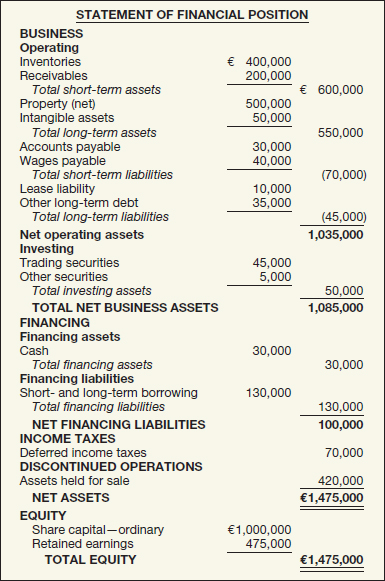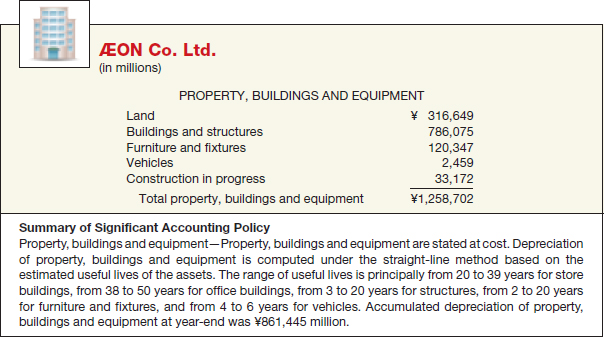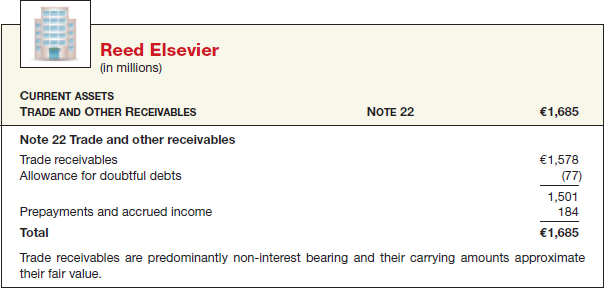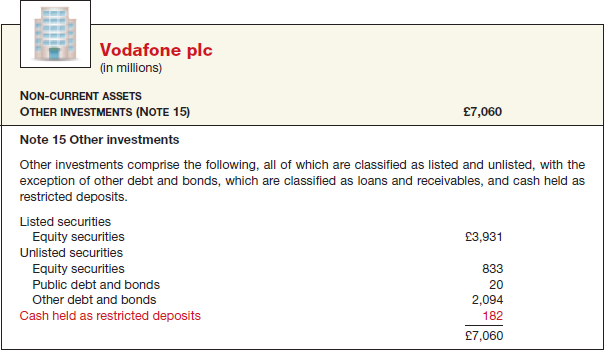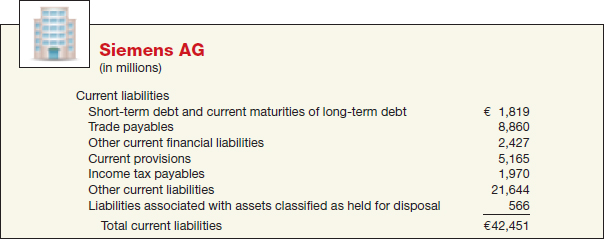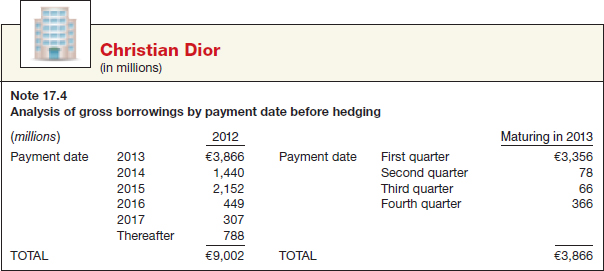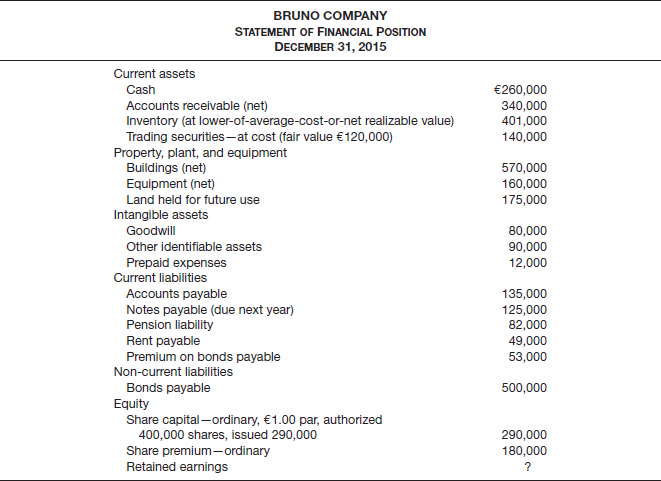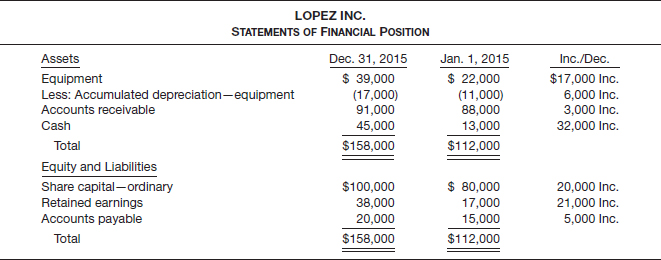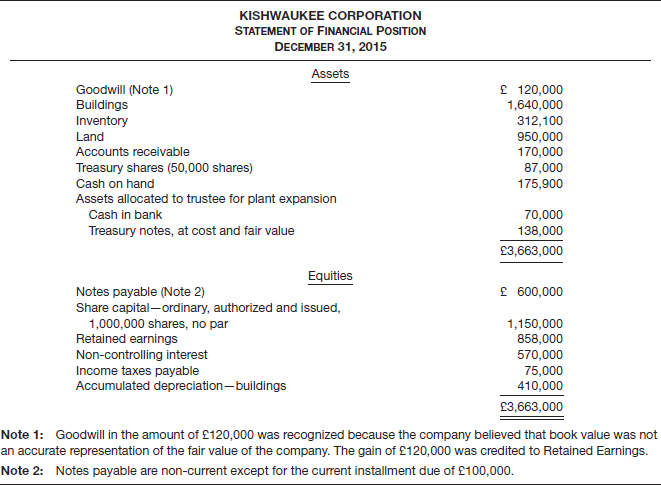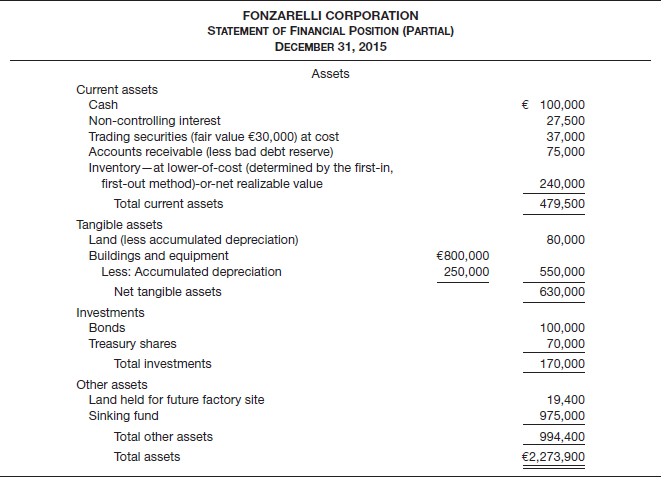LEARNING OBJECTIVES
After studying this chapter, you should be able to:
- 1 Explain the uses and limitations of a statement of financial position.
- 2 Identify the major classifications of the statement of financial position.
- 3 Prepare a classified statement of financial position using the report and account formats.
- 4 Indicate the purpose of the statement of cash flows.
- 5 Identify the content of the statement of cash flows.
- 6 Prepare a basic statement of cash flows.
- 7 Understand the usefulness of the statement of cash flows.
- 8 Determine additional information requiring note disclosure.
- 9 Describe the major disclosure techniques for financial statements.
Hey, It Doesn't Balance!
A good accounting student knows by now that Total Assets = Total Liabilities + Total Equity. From this equation, we can also determine net assets, which are determined as follows: Total Assets − Total Liabilities = Net Assets. O.K., this is simple so far. But let's look at the discussion paper by the IASB on how the statement of financial position (often referred to as the balance sheet) should be structured.
The statement of financial position is divided into five major parts, with many assets and liabilities netted against one another. Here is the general framework for the new statement of financial position:

The statement does look a bit different than the traditional balance sheet. Let's put some numbers to the statement and see how it works. (See the example on the facing page.)
Well, it does balance—in that net assets equal equity—but isn't it important to know total assets and total liabilities? As some have observed, the statement of financial position will not balance the way we expect it to. That is, assets won't equal liabilities and equity. This is because the assets and liabilities are grouped into the business, financing, discontinued operations, and income taxes categories. This new model raises a number of questions, such as:
- Does separating “business activities” from “financing activities” provide information that is more decision-useful?
- Does information on income taxes and discontinued operations merit separate categories?
The IASB is working to get answers to these and other questions about this proposed model. One thing is for sure—adoption of the new financial statement will be a dramatic change but hopefully one for the better.
Sources: Marie Leone and Tim Reason, “How Extreme Is the Makeover?” CFO Magazine (March 1, 2009); and Preliminary Views on Financial Statement Presentation, FASB/IASB Discussion Paper (October 2008).
PREVIEW OF CHAPTER 5
As the opening story indicates, the IASB is currently working to improve the presentation of financial information on the statement of financial position, as well as other financial statements. In this chapter, we examine the many different types of assets, liabilities, and equity items that affect the statement of financial position and the statement of cash flows. The content and organization of the chapter are as follows.

STATEMENT OF FINANCIAL POSITION
LEARNING OBJECTIVE ![]()
Explain the uses and limitations of a statement of financial position.
The statement of financial position, also referred to as the balance sheet, reports the assets, liabilities, and equity of a business enterprise at a specific date.1 This financial statement provides information about the nature and amounts of investments in enterprise resources, obligations to creditors, and the equity in net resources. It therefore helps in predicting the amounts, timing, and uncertainty of future cash flows.
Usefulness of the Statement of Financial Position
By providing information on assets, liabilities, and equity, the statement of financial position provides a basis for computing rates of return and evaluating the capital structure of the enterprise. Analysts also use information in the statement of financial position to assess a company's risk2 and future cash flows. In this regard, analysts use the statement of financial position to assess a company's liquidity, solvency, and financial flexibility.
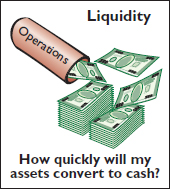
Liquidity describes “the amount of time that is expected to elapse until an asset is realized or otherwise converted into cash or until a liability has to be paid.” Creditors are interested in short-term liquidity ratios, such as the ratio of cash (or near cash) to short-term liabilities. These ratios indicate whether a company, like adidas (DEU), will have the resources to pay its current and maturing obligations. Similarly, shareholders assess liquidity to evaluate the possibility of future cash dividends or the buyback of shares. In general, the greater adidas' liquidity, the lower its risk of failure.
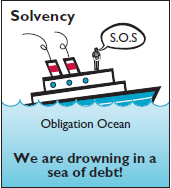
Solvency refers to the ability of a company to pay its debts as they mature. For example, when a company carries a high level of long-term debt relative to assets, it has lower solvency than a similar company with a low level of long-term debt. Companies with higher debt are relatively more risky because they will need more of their assets to meet their fixed obligations (interest and principal payments).
Liquidity and solvency affect a company's financial flexibility, which measures the ability of a company to take effective actions to alter the amounts and timing of cash flows so it can respond to unexpected needs and opportunities. For example, a company may become so loaded with debt—so financially inflexible—that it has little or no sources of cash to finance expansion or to pay off maturing debt. A company with a high degree of financial flexibility is better able to survive bad times, to recover from unexpected setbacks, and to take advantage of profitable and unexpected investment opportunities. Generally, the greater an enterprise's financial flexibility, the lower its risk of failure.

Limitations of the Statement of Financial Position
![]() See the Authoritative Literature section (page 215).
See the Authoritative Literature section (page 215).
Some of the major limitations of the statement of financial position are:
- 1. Most assets and liabilities are reported at historical cost. As a result, the information provided in the statement of financial position is often criticized for not reporting a more relevant fair value. For example, Pemex (MEX) owns crude oil and natural gas that may appreciate in value. Yet, it reports any increase only if and when it sells the assets.
- 2. Companies use judgments and estimates to determine many of the items reported in the statement of financial position. For example, in its statement of financial position, Lenovo (CHN) estimates the amount of receivables that it will collect, the useful life of its warehouses, and the number of computers that will be returned under warranty.
- 3. The statement of financial position necessarily omits many items that are of financial value but that a company cannot record objectively. For example, the knowledge and skill of Intel (USA) employees in developing new computer chips are arguably the company's most significant asset. However, because Intel cannot reliably measure the value of its employees and other intangible assets (such as customer base, research superiority, and reputation), it does not recognize these items in the statement of financial position. Similarly, many liabilities are reported in an “off-balance-sheet” manner, if at all.
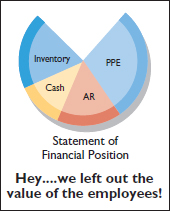
The bankruptcy of Enron (USA), the seventh-largest U.S. company at the time, highlights the omission of important items in the statement of financial position. In Enron's case, it failed to disclose certain off-balance-sheet financing obligations in its main financial statements.
Classification in the Statement of Financial Position
![]() LEARNING OBJECTIVE
LEARNING OBJECTIVE
Identify the major classifications of the statement of financial position.
Statement of financial position accounts are classified. That is, a statement of financial position groups together similar items to arrive at significant subtotals. Furthermore, the material is arranged so that important relationships are shown.
The IASB indicates that the parts and subsections of financial statements are more informative than the whole. Therefore, the IASB discourages the reporting of summary accounts alone (total assets, net assets, total liabilities, etc.). Instead, companies should report and classify individual items in sufficient detail to permit users to assess the amounts, timing, and uncertainty of future cash flows. Such classification also makes it easier for users to evaluate the company's liquidity and financial flexibility, profitability, and risk.
To classify items in financial statements, companies group those items with similar characteristics and separate items with different characteristics. For example, companies should report separately:
- 1. Assets and liabilities with different general liquidity characteristics. For example, Nokia (FIN) reports cash separately from inventories.
- 2. Assets that differ in their expected function in the company's central operations or other activities. For example, Puma (DEU) reports merchandise inventories separately from property, plant, and equipment. Similarly, a company like Marks and Spencer plc (GBR) that uses assets in its operations should report these assets differently from assets held for investments and assets subject to restrictions, such as leased facilities.
- 3. Liabilities that differ in their amounts, nature, and timing. For example, Royal Ahold (NLD) should report accounts payable separately from its pension liability.
The three general classes of items included in the statement of financial position are assets, liabilities, and equity. We defined them in Chapter 2 as follows.3
ELEMENTS OF THE STATEMENT OF FINANCIAL POSITION
- 1 ASSET. Resource controlled by the entity as a result of past events and from which future economic benefits are expected to flow to the entity.
- 2 LIABILITY. Present obligation of the entity arising from past events, the settlement of which is expected to result in an outflow from the entity of resources embodying economic benefits.
- 3 EQUITY. Residual interest in the assets of the entity after deducting all its liabilities.
Companies then further divide these items into several subclassifications. Illustration 5-1 indicates the general format of statement of financial position presentation.
ILLUSTRATION 5-1
Statement of Financial Position Classification

What do the numbers mean? WHAT COMES FIRST?
There is much discussion involving the format of the financial statements. An interesting question is whether current assets or non-current assets should be shown first on the statement of financial position. Recently, a survey was done of 175 international companies which showed the following trends in the order in which assets are presented.
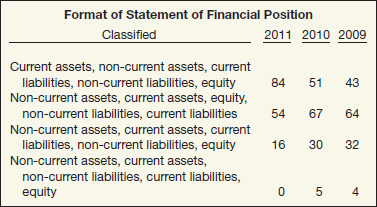
This survey shows that companies are moving toward reporting current assets first on the statement of financial position, which is a change from a few years ago. Recognize that companies are required to present a classified statement of financial position except when one based on liquidity provides more relevant information. Therefore, either current assets or non-current assets can be shown first. The important point is that financial statement users have a good understanding of what is going to be realized in cash in the short-term versus the long-term.
Source: P. Walters, “IFRS Financial Statements,” Accounting Trends and Techniques—2012 (New York: AICPA), p. 117.
Non-Current Assets
Current assets are cash and other assets a company expects to convert to cash, sell, or consume either in one year or the operating cycle, whichever is longer. Non-current assets are those not meeting the definition of current assets. They include a variety of items, as we discuss in the following sections.
Long-Term Investments. Long-term investments, often referred to simply as investments, normally consist of one of four types:
- 1. Investments in securities, such as bonds, ordinary shares, or long-term notes.
- 2. Investments in tangible assets not currently used in operations, such as land held for speculation.
- 3. Investments set aside in special funds, such as a sinking fund, pension fund, or plant expansion fund.
- 4. Investments in non-consolidated subsidiaries or associated companies.
Companies group investments in debt and equity securities into three separate portfolios for valuation and reporting purposes:
- Held-for-collection: Debt securities that a company manages to collect contractual principal and interest payments.
- Trading (also referred to as designated at fair value through profit or loss): Debt and equity securities bought and held primarily for sale in the near term to generate income on short-term price changes.
- Non-trading equity: Certain equity securities held for purposes other than trading (e.g., to meet a legal or contractual requirement).
We further discuss the held-for-collection and non-trading equity securities in Chapter 17.4
A company should report trading securities (whether debt or equity) as current assets. It classifies individual held-for-collection and non-trading equity securities as current or non-current, depending on the circumstances. It should report held-for-collection securities at amortized cost. All trading and non-trading equity securities are reported at fair value.[3]
Christian Dior (FRA) reported its investments as follows.
ILLUSTRATION 5-2
Statement of Financial Position Presentation of Long-Term Investments

Property, Plant, and Equipment. Property, plant, and equipment are tangible long-lived assets used in the regular operations of the business. These assets consist of physical property such as land, buildings, machinery, furniture, tools, and wasting resources (minerals). With the exception of land, a company either depreciates (e.g., buildings) or depletes (e.g., oil reserves) these assets.
ÆON Co. Ltd. (JPN) presented its property, plant, and equipment in its statement of financial position as shown in Illustration 5-3 (on page 186).
ILLUSTRATION 5-3
Statement of Financial Position Presentation of Property, Plant, and Equipment
A company discloses the basis it uses to value property, plant, and equipment; any liens against the properties; and accumulated depreciation—usually in the notes to the statements.
Intangible Assets. Intangible assets lack physical substance and are not financial instruments.5 They include patents, copyrights, franchises, goodwill, trademarks, trade names, and customer lists. A company writes off (amortizes) limited-life intangible assets over their useful lives. It periodically assesses indefinite-life intangibles (such as goodwill) for impairment. Intangibles can represent significant economic resources, yet financial analysts often ignore them, because valuation is difficult. Research and development costs are expensed as incurred except for certain development costs, which are capitalized when it is probable that a development project will generate future economic benefits.
Nokia (FIN) reported intangible assets in its statement of financial position as follows.
ILLUSTRATION 5-4
Statement of Financial Position Presentation of Intangible Assets

Other Assets. The items included in the section “Other assets” vary widely in practice. Some include items such as long-term prepaid expenses and non-current receivables. Other items that might be included are assets in special funds, property held for sale, and restricted cash or securities. A company should limit this section to include only unusual items sufficiently different from assets included in specific categories.
Current Assets
As indicated earlier, current assets are cash and other assets a company expects to convert into cash, sell, or consume either in one year or in the operating cycle, whichever is longer. The operating cycle is the average time between when a company acquires materials and supplies and when it receives cash for sales of the product (for which it acquired the materials and supplies). The cycle operates from cash through inventory, production, receivables, and back to cash. When several operating cycles occur within one year (which is generally the case for service companies), a company uses the one-year period. If the operating cycle is more than one year, a company uses the longer period.
The five major items found in the current assets section, and their bases of valuation, are shown in Illustration 5-5. These assets are generally presented in the following order.
ILLUSTRATION 5-5
Current Assets and Basis of Valuation

A company does not report these five items as current assets if it does not expect to realize them in one year or in the operating cycle, whichever is longer. For example, a company excludes from the current assets section cash restricted for purposes other than payment of current obligations or for use in current operations. Generally, if a company expects to convert an asset into cash or to use it to pay a current liability within a year or the operating cycle, whichever is longer, it classifies the asset as current.
This rule, however, is subject to interpretation. A company classifies an investment in non-trading equity securities as either a current asset or a non-current asset, depending on management's intent. When it has holdings of ordinary or preference shares or bonds that it will hold long-term, it should not classify them as current.
Although a current asset is well defined, certain theoretical problems also develop. For example, how is inclusion of prepaid expenses in the current assets section justified? The rationale is that if a company did not pay these items in advance, it would instead need to use other current assets during the operating cycle. If we follow this logic to its ultimate conclusion, however, any asset previously purchased saves the use of current assets during the operating cycle and would be considered current.
Another problem occurs in the current-asset definition when a company consumes plant assets during the operating cycle. Conceptually, it seems that a company should place in the current assets section an amount equal to the current depreciation charge on the plant assets, because it will consume them in the next operating cycle. However, this conceptual problem is ignored. This example illustrates that the formal distinction made between some current and non-current assets is somewhat arbitrary.
Inventories. To present inventories properly, a company discloses the basis of valuation (e.g., lower-of-cost-or-net realizable value) and the cost flow assumption used (e.g., FIFO or average-cost). Presented in Illustration 5-6 is how Royal Ahold (NLD) reports its inventories.
ILLUSTRATION 5-6
Statement of Financial Position Presentation of Inventories
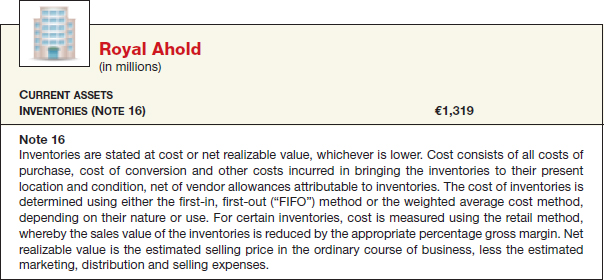
A manufacturing company, like Acer Incorporated (TWN), also indicates the stage of completion for inventory, as shown in Illustration 5-7. Note that Acer shows amounts both in New Taiwan dollars (NT$) and U.S. dollars ($).
ILLUSTRATION 5-7
Statement of Financial Position Presentation of Inventories

Receivables. A company should clearly identify any anticipated loss due to uncollectibles, the amount and nature of any non-trade receivables, and any receivables used as collateral. Major categories of receivables should be shown in the statement of financial position or the related notes. For receivables arising from unusual transactions (such as sale of property, or a loan to associates or employees), companies should separately classify these as long-term, unless collection is expected within one year. Reed Elsevier (GBR) reported its receivables as shown in Illustration 5-8.
ILLUSTRATION 5-8
Statement of Financial Position Presentation of Receivables
Prepaid Expenses. A company includes prepaid expenses in current assets if it will receive benefits (usually services) within one year or the operating cycle, whichever is longer. As we discussed earlier, these items are current assets because if they had not already been paid, they would require the use of cash during the next year or the operating cycle. A company reports prepaid expenses at the amount of the unexpired or unconsumed cost.
A common example is the prepayment for an insurance policy. A company classifies it as a prepaid expense because the payment precedes the receipt of the benefit of coverage. Other common prepaid expenses include prepaid rent, advertising, taxes, and office or operating supplies. adidas (DEU) reports prepaid expenses in other current assets, along with tax receivables other than income taxes and derivative financial assets, as shown in Illustration 5-9.
ILLUSTRATION 5-9
Statement of Financial Position Presentation of Prepaid Expenses
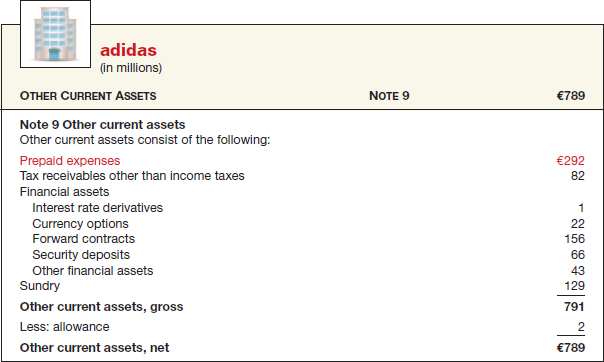
Short-Term Investments. As indicated earlier, a company should report trading securities (whether debt or equity) as current assets. It classifies individual non-trading investments as current or non-current, depending on the circumstances. It should report held-for-collection (sometimes referred to as held-to-maturity) securities at amortized cost. All trading securities are reported at fair value.6
Illustration 5-10 provides an excerpt from the annual report of AB InBev (BEL) with respect to its short-term financial assets.
ILLUSTRATION 5-10
Statement of Financial Position Presentation of Short-Term Investments
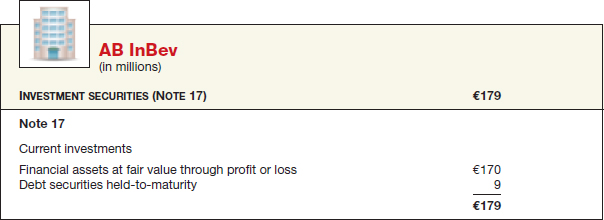
Cash. Cash is generally considered to consist of currency and demand deposits (monies available on demand at a financial institution). Cash equivalents are short-term, highly liquid investments that will mature within three months or less. Most companies use the caption “Cash and cash equivalents,” and they indicate that this amount approximates fair value. As an example, see the excerpt from adidas (DEU) in Illustration 5-11.
ILLUSTRATION 5-11
Statement of Financial Position Presentation of Cash and Cash Equivalents

A company must disclose any restrictions or commitments related to the availability of cash. If a company restricts cash for purposes other than current obligations, it excludes the cash from current assets. Illustration 5-12 shows an example of this, from the annual report of Vodafone plc (GBR).
ILLUSTRATION 5-12
Statement of Financial Position Presentation of Restricted Cash
Equity
The equity (also referred to as shareholders' equity) section is one of the most difficult sections to prepare and understand. This is due to the complexity of ordinary and preference share agreements and the various restrictions on equity imposed by corporation laws, liability agreements, and boards of directors. Companies usually divide the section into six parts:
EQUITY SECTION
- 1. SHARE CAPITAL. The par or stated value of shares issued. It includes ordinary shares (sometimes referred to as common shares) and preference shares (sometimes referred to as preferred shares).
- 2. SHARE PREMIUM. The excess of amounts paid-in over the par or stated value.
- 3. RETAINED EARNINGS. The corporation's undistributed earnings.
- 4. ACCUMULATED OTHER COMPREHENSIVE INCOME. The aggregate amount of the other comprehensive income items.
- 5. TREASURY SHARES. Generally, the amount of ordinary shares repurchased.
- 6. NON-CONTROLLING INTEREST (MINORITY INTEREST). A portion of the equity of subsidiaries not owned by the reporting company.
For ordinary shares, companies must disclose the par value and the authorized, issued, and outstanding share amounts. The same holds true for preference shares. A company usually presents the share premium (for both ordinary and preference shares) in one amount although subtotals are informative if the sources of additional capital are varied and material. The retained earnings amount may be divided between the unappropriated (the amount that is usually available for dividend distribution) and restricted (e.g., by bond indentures or other loan agreements) amounts. In addition, companies show any shares reacquired (treasury shares) as a reduction of equity.
Accumulated other comprehensive income (sometimes referred to as reserves or other reserves) includes such items as unrealized gains and losses on non-trading equity securities and unrealized gains and losses on certain derivative transactions. Non-controlling interest, sometimes referred to as minority interest, is also shown as a separate item (where applicable) as a part of equity.
Illustration 5-13 presents an example of the equity section for Delhaize Group (BEL).
ILLUSTRATION 5-13
Statement of Financial Position Presentation of Equity
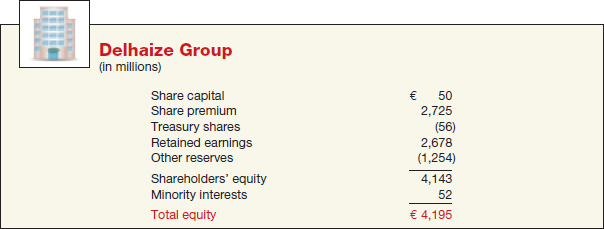
Many companies reporting under IFRS often use the term “reserve” as an all-inclusive catch-all for items such as retained earnings, share premium, and accumulated other comprehensive income. An example of such a presentation is shown for Lenovo Group Limited (CHN).
ILLUSTRATION 5-14
Statement of Financial Position Presentation of Reserves

The equity accounts in a corporation differ considerably from those in a partnership or proprietorship. Partners show separately their permanent capital accounts and the balance in their temporary accounts (drawing accounts). Proprietorships ordinarily use a single capital account that handles all of the owner's equity transactions.
Non-Current Liabilities
Non-current liabilities are obligations that a company does not reasonably expect to liquidate within the longer of one year or the normal operating cycle. Instead, it expects to pay them at some date beyond that time. The most common examples are bonds payable, notes payable, some deferred income tax amounts, lease obligations, and pension obligations. Companies classify non-current liabilities that mature within the current operating cycle or one year as current liabilities if payment of the obligation requires the use of current assets.
Generally, non-current liabilities are of three types:
- 1. Obligations arising from specific financing situations, such as the issuance of bonds, long-term lease obligations, and long-term notes payable.
- 2. Obligations arising from the ordinary operations of the company, such as pension obligations and deferred income tax liabilities.
- 3. Obligations that depend on the occurrence or non-occurrence of one or more future events to confirm the amount payable, or the payee, or the date payable, such as service or product warranties, environmental liabilities, and restructurings, often referred to as provisions.
Companies generally provide a great deal of supplementary disclosure for non-current liabilities because most long-term debt is subject to various covenants and restrictions for the protection of lenders.
Companies frequently describe the terms of all non-current liability agreements (including maturity date or dates, rates of interest, nature of obligation, and any security pledged to support the debt) in notes to the financial statements. Illustration 5-15 provides an example of this, taken from an excerpt from Silver Fern Farms Limited's (NZL) financials.
ILLUSTRATION 5-15
Statement of Financial Position Presentation of Non-Current Liabilities

Current Liabilities
Current liabilities are the obligations that a company generally expects to settle in its normal operating cycle or one year, whichever is longer. This concept includes:
- 1. Payables resulting from the acquisition of goods and services: accounts payable, salaries and wages payable, income taxes payable, and so on.
- 2. Collections received in advance for the delivery of goods or performance of services, such as unearned rent revenue or unearned subscriptions revenue.
- 3. Other liabilities whose liquidation will take place within the operating cycle or one year, such as the portion of long-term bonds to be paid in the current period, short-term obligations arising from purchase of equipment, or estimated liabilities, such as a warranty liability. As indicated earlier, estimated liabilities are often referred to as provisions.
At times, a liability that is payable within the next year is not included in the current liabilities section. This occurs when the company refinances the debt on a long-term basis before the end of the reporting period. [6] This approach is used because liquidation does not result from the use of current assets or the creation of other current liabilities.
Companies do not report current liabilities in any consistent order. In general, though, companies most commonly list notes payable, accounts payable, or short-term debt as the first item. Income tax payables or other current liabilities are commonly listed last. For example, see Siemens AG's (DEU) current liabilities section in Illustration 5-16 (on page 194).
ILLUSTRATION 5-16
Statement of Financial Position Presentation of Current Liabilities
Current liabilities include such items as trade and non-trade notes and accounts payable, advances received from customers, and current maturities of long-term debt. If the amounts are material, companies classify income taxes and other accrued items separately. A company should fully describe in the notes any information about a secured liability—for example, shares held as collateral on notes payable—to identify the assets providing the security.
The excess of total current assets over total current liabilities is referred to as working capital (or sometimes net working capital). Working capital represents the net amount of a company's relatively liquid resources. That is, it is the liquidity buffer available to meet the financial demands of the operating cycle.
Companies seldom disclose on the statement of financial position an amount for working capital. But bankers and other creditors compute it as an indicator of the short-run liquidity of a company. To determine the actual liquidity and availability of working capital to meet current obligations, however, requires analysis of the composition of the current assets and their nearness to cash.
Statement of Financial Position Format
LEARNING OBJECTIVE ![]()
Prepare a classified statement of financial position using the report and account formats.
As indicated earlier, IFRS does not specify the order or format in which a company presents items in the statement of financial position (see the “What do the numbers mean?” box on page 184). Thus, some companies present assets first, followed by equity, and then liabilities. Other companies report current assets first in the assets section, and current liabilities first in the liabilities section. Many companies report items such as receivables and property, plant, and equipment net and then disclose the additional information related to the contra accounts in the notes.
In general, companies use either the account form or the report form to present the statement of financial position information. The account form lists assets, by sections, on the left side, and equity and liabilities, by sections, on the right side. The main disadvantage is the need for a sufficiently wide space in which to present the items side by side. Often, the account form requires two facing pages.
To avoid this disadvantage, the report form lists the sections one above the other, on the same page. See, for example, Illustration 5-17, which lists assets, followed by equity and liabilities directly below, on the same page.
Infrequently, companies use other statement of financial position formats. For example, companies sometimes deduct current liabilities from current assets to arrive at working capital. Or, they deduct all liabilities from all assets.
ILLUSTRATION 5-17
Classified Report-Form Statement of Financial Position
What do the numbers mean? WARNING SIGNALS
Analysts use statement of financial position information in models designed to predict financial distress. Researcher E. I. Altman pioneered a bankruptcy-prediction model that derives a “Z-score” by combining statement of financial position and income measures in the following equation.

Following extensive testing, Altman found that companies with Z-scores above 3.0 are unlikely to fail. Those with Z-scores below 1.81 are very likely to fail.
Altman developed the original model for publicly held manufacturing companies. He and others have modified the model to apply to companies in various industries, emerging companies, and companies not traded in public markets.
At one time, the use of Z-scores was virtually unheard of among practicing accountants. Today, auditors, management consultants, and courts of law use this measure to help evaluate the overall financial position and trends of a firm. In addition, banks use Z-scores for loan evaluation. While a low score does not guarantee bankruptcy, the model has been proven accurate in many situations.
Source: Adapted from E. I. Altman and E. Hotchkiss, Corporate Financial Distress and Bankruptcy, Third Edition (New York: John Wiley and Sons, 2005).
STATEMENT OF CASH FLOWS
LEARNING OBJECTIVE ![]()
Indicate the purpose of the statement of cash flows.
Chapter 2 indicated that an important element of the objective of financial reporting is “assessing the amounts, timing, and uncertainty of cash flows.” The three financial statements we have looked at so far—the income statement (or statement of comprehensive income), the statement of changes in equity, and the statement of financial position—each present some information about the cash flows of an enterprise during a period. But they do so to a limited extent. For instance, the income statement provides information about resources provided by operations but not exactly cash. The statement of changes in equity shows the amount of cash used to pay dividends or purchase treasury shares. Comparative statements of financial position might show what assets the company has acquired or disposed of and what liabilities it has incurred or liquidated.
Useful as they are, none of these statements presents a detailed summary of all the cash inflows and outflows, or the sources and uses of cash during the period. To fill this need, the IASB requires the statement of cash flows (also called the cash flow statement).[7]
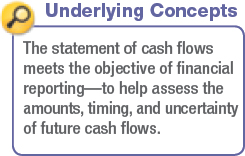
Purpose of the Statement of Cash Flows
The primary purpose of the statement of cash flows is to provide relevant information about the cash receipts and cash payments of an enterprise during a period. To achieve this purpose, the statement of cash flows reports the following: (1) the cash effects of operations during a period, (2) investing transactions, (3) financing transactions, and (4) the net increase or decrease in cash during the period.7
Reporting the sources, uses, and net increase or decrease in cash helps investors, creditors, and others know what is happening to a company's most liquid resource. Because most individuals maintain a checkbook and prepare a tax return on a cash basis, they can comprehend the information reported in the statement of cash flows.
The statement of cash flows provides answers to the following simple but important questions:
- 1. Where did the cash come from during the period?
- 2. What was the cash used for during the period?
- 3. What was the change in the cash balance during the period?
What do the numbers mean? WATCH THAT CASH FLOW
Investors usually focus on net income measured on an accrual basis. However, information on cash flows can be important for assessing a company's liquidity, financial flexibility, and overall financial performance. The graph below shows a company's financial performance over 7 years.
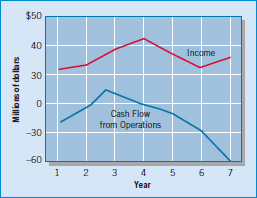
Although this company showed consistent profits and even some periods of earnings growth, its cash flow began to “go south” starting in about year 3. The company filed for bankruptcy shortly after year 7. Thus, financial statement readers who studied the company's cash flows would have found indications of this company's problems well before year 7. This case illustrates the importance of cash flows as an early-warning signal of financial problems.
Another retailer case is Target (USA). Although Target has shown good profits, some are concerned that a bit too much of its sales have been made on credit rather than cash. Why is this a problem? Like the example illustrated above, the earnings of profitable lenders can get battered in future periods if they have to start adding large amounts to their bad-loan reserve to catch up with credit losses. And if losses ramp up on Target-branded credit cards, Target may get hit in this way.
Source: Peter Eavis, “Is Target Corp.'s Credit Too Generous?” Wall Street Journal (March 11, 2008), p. C1.
Content and Format of the Statement of Cash Flows
Companies classify cash receipts and cash payments during a period into three different activities in the statement of cash flows—operating, investing, and financing activities, defined as follows.
![]() LEARNING OBJECTIVE
LEARNING OBJECTIVE
Identify the content of the statement of cash flows.
- 1. Operating activities involve the cash effects of transactions that enter into the determination of net income.
- 2. Investing activities include making and collecting loans and acquiring and disposing of investments (both debt and equity) and property, plant, and equipment.
- 3. Financing activities involve liability and equity items. They include (a) obtaining resources from owners and providing them with a return on their investment, and (b) borrowing money from creditors and repaying the amounts borrowed.
Illustration 5-18 shows the basic format of the statement of cash flows.
ILLUSTRATION 5-18
Basic Format of Cash Flow Statement

Illustration 5-19 graphs the inflows and outflows of cash classified by activity.
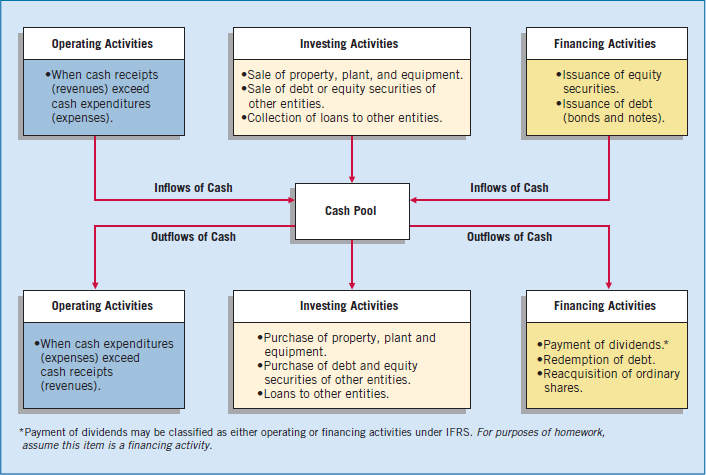
ILLUSTRATION 5-19
Cash Inflows and Outflows
The statement's value is that it helps users evaluate liquidity, solvency, and financial flexibility. As stated earlier, liquidity refers to the “nearness to cash” of assets and liabilities. Solvency is the firm's ability to pay its debts as they mature. Financial flexibility is a company's ability to respond and adapt to financial adversity and unexpected needs and opportunities.
We have devoted Chapter 23 entirely to the detailed preparation and content of the statement of cash flows. The intervening chapters will cover several elements and complex topics that affect the content of a typical statement of cash flows. The presentation in this chapter is introductory—a reminder of the existence of the statement of cash flows and its usefulness.
Overview of the Preparation of the Statement of Cash Flows
Sources of Information
LEARNING OBJECTIVE ![]()
Prepare a basic statement of cash flows.
Companies obtain the information to prepare the statement of cash flows from several sources: (1) comparative statements of financial position, (2) the current income statement, and (3) selected transaction data.
The following simple example demonstrates how companies use these sources in preparing a statement of cash flows.
On January 1, 2015, in its first year of operations, Telemarketing Inc. issued 50,000 ordinary shares of $1 par value for $50,000 cash. The company rented its office space, furniture, and telecommunications equipment and performed marketing services throughout the first year. In June 2015, the company purchased land for $15,000. Illustration 5-20 shows the company's comparative statements of financial position at the beginning and end of 2015.
ILLUSTRATION 5-20
Comparative Statements of Financial Position
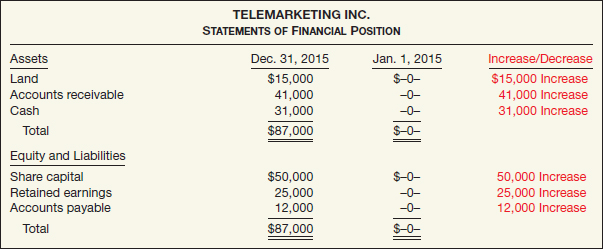
Illustration 5-21 presents the income statement and additional information.
ILLUSTRATION 5-21
Income Statement Data
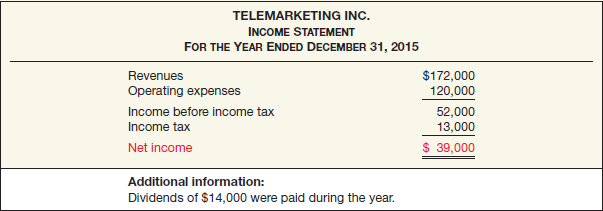
Preparing the Statement of Cash Flows
Preparing the statement of cash flows from these sources involves four steps:
- 1. Determine the net cash provided by (or used in) operating activities.
- 2. Determine the net cash provided by (or used in) investing and financing activities.
- 3. Determine the change (increase or decrease) in cash during the period.
- 4. Reconcile the change in cash with the beginning and the ending cash balances.
Net cash provided by operating activities is the excess of cash receipts over cash payments from operating activities. Companies determine this amount by converting net income on an accrual basis to a cash basis. To do so, they add to or deduct from net income those items in the income statement that do not affect cash. This procedure requires that a company analyze not only the current year's income statement but also the comparative statements of financial position and selected transaction data.
Analysis of Telemarketing's comparative statements of financial position reveals two items that will affect the computation of net cash provided by operating activities:
- 1. The increase in accounts receivable reflects a non-cash increase of $41,000 in revenues.
- 2. The increase in accounts payable reflects a non-cash increase of $12,000 in expenses.
Therefore, to arrive at net cash provided by operating activities, Telemarketing Inc. deducts from net income the increase in accounts receivable ($41,000), and it adds back to net income the increase in accounts payable ($12,000). As a result of these adjustments, the company determines net cash provided by operating activities to be $10,000, computed as shown in Illustration 5-22.
ILLUSTRATION 5-22
Computation of Net Cash Provided by Operating Activities

Next, the company determines its investing and financing activities. Telemarketing Inc.'s only investing activity was the land purchase. It had two financing activities. (1) Share capital—ordinary increased $50,000 from the issuance of 50,000 ordinary shares for cash. (2) The company paid $14,000 cash in dividends. Knowing the amounts provided/used by operating, investing, and financing activities, the company determines the net increase in cash. Illustration 5-23 presents Telemarketing Inc.'s statement of cash flows for 2015.
ILLUSTRATION 5-23
Statement of Cash Flows

The increase in cash of $31,000 reported in the statement of cash flows agrees with the increase of $31,000 in cash calculated from the comparative statements of financial position.8
Significant Non-Cash Activities
Not all of a company's significant activities involve cash. Examples of significant non-cash activities are:
- 1. Issuance of ordinary shares to purchase assets.
- 2. Conversion of bonds into ordinary shares.
- 3. Issuance of debt to purchase assets.
- 4. Exchanges of long-lived assets.
Significant financing and investing activities that do not affect cash are not reported in the body of the statement of cash flows. Rather, these activities are reported in a separate note to the financial statements. Such reporting of these non-cash activities satisfies the full disclosure principle.
Illustration 5-24 shows an example of a comprehensive statement of cash flows. Note that the company purchased equipment through the issuance of €50,000 of bonds, which is a significant non-cash transaction. For homework purposes, you should present significant non-cash activities in a separate note entitled “Cash Flow Note.”
ILLUSTRATION 5-24
Comprehensive Statement of Cash Flows
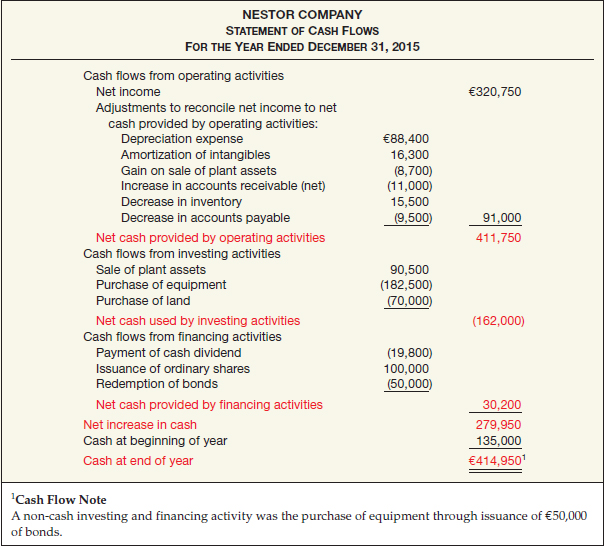
Usefulness of the Statement of Cash Flows
![]() LEARNING OBJECTIVE
LEARNING OBJECTIVE
Understand the usefulness of the statement of cash flows.
“Happiness is a positive cash flow” is certainly true. Although net income provides a long-term measure of a company's success or failure, cash is its lifeblood. Without cash, a company will not survive. For small and newly developing companies, cash flow is the single most important element for survival. Even medium and large companies must control cash flow.
Creditors examine the cash flow statement carefully because they are concerned about being paid. They begin their examination by finding net cash provided by operating activities. A high amount indicates that a company is able to generate sufficient cash from operations to pay its bills without further borrowing. Conversely, a low or negative amount of net cash provided by operating activities indicates that a company may have to borrow or issue equity securities to acquire sufficient cash to pay its bills. Consequently, creditors look for answers to the following questions in the company's cash flow statements.
- 1. How successful is the company in generating net cash provided by operating activities?
- 2. What are the trends in net cash flow provided by operating activities over time?
- 3. What are the major reasons for the positive or negative net cash provided by operating activities?
You should recognize that companies can fail even though they report net income. The difference between net income and net cash provided by operating activities can be substantial. Companies sometimes report high net income numbers but negative net cash provided by operating activities. This type of situation can eventually lead to bankruptcy.
In addition, substantial increases in receivables and/or inventory can explain the difference between positive net income and negative net cash provided by operating activities. For example, in its first year of operations Hu Inc. reported a net income of HK$80,000. Its net cash provided by operating activities, however, was a negative HK$95,000, as shown in Illustration 5-25.
ILLUSTRATION 5-25
Negative Net Cash Provided by Operating Activities

Hu could easily experience a “cash crunch” because it has its cash tied up in receivables and inventory. If Hu encounters problems in collecting receivables, or if inventory moves slowly or becomes obsolete, its creditors may have difficulty collecting on their loans.
Financial Liquidity
Readers of financial statements often assess liquidity by using the current cash debt coverage. It indicates whether the company can pay off its current liabilities from its operations in a given year. Illustration 5-26 shows the formula for this ratio.
ILLUSTRATION 5-26
Formula for Current Cash Debt Coverage
![]()
The higher the current cash debt coverage, the less likely a company will have liquidity problems. For example, a ratio near 1:1 is good. It indicates that the company can meet all of its current obligations from internally generated cash flow.
Financial Flexibility
The cash debt coverage provides information on financial flexibility. It indicates a company's ability to repay its liabilities from net cash provided by operating activities, without having to liquidate the assets employed in its operations. Illustration 5-27 shows the formula for this ratio. Notice its similarity to the current cash debt coverage. However, because it uses average total liabilities in place of average current liabilities, it takes a somewhat longer-range view.
ILLUSTRATION 5-27
Formula for Cash Debt Coverage
![]()
The higher this ratio, the less likely the company will experience difficulty in meeting its obligations as they come due. It signals whether the company can pay its debts and survive if external sources of funds become limited or too expensive.
Free Cash Flow
A more sophisticated way to examine a company's financial flexibility is to develop a free cash flow analysis. Free cash flow is the amount of discretionary cash flow a company has. It can use this cash flow to purchase additional investments, retire its debt, purchase treasury shares, or simply add to its liquidity. Financial statement users calculate free cash flow as shown in Illustration 5-28.
ILLUSTRATION 5-28
Formula for Free Cash Flow

In a free cash flow analysis, we first deduct capital spending to indicate it is the least discretionary expenditure a company generally makes. (Without continued efforts to maintain and expand facilities, it is unlikely that a company can continue to maintain its competitive position.) We then deduct dividends. Although a company can cut its dividend, it usually will do so only in a financial emergency. The amount resulting after these deductions is the company's free cash flow. Obviously, the greater the amount of free cash flow, the greater the company's amount of financial flexibility.
Questions that a free cash flow analysis answers are:
- 1. Is the company able to pay its dividends without resorting to external financing?
- 2. If business operations decline, will the company be able to maintain its needed capital investment?
- 3. What is the amount of discretionary cash flow that can be used for additional investment, retirement of debt, purchase of treasury shares, or addition to liquidity?
Illustration 5-29 is a free cash flow analysis using the cash flow statement for Nestor Company (shown in Illustration 5-24 on page 201).
ILLUSTRATION 5-29
Free Cash Flow Computation

This computation shows that Nestor has a positive, and substantial, net cash provided by operating activities of €411,750. Nestor's statement of cash flows reports that the company purchased equipment of €182,500 and land of €70,000 for total capital spending of €252,500. Nestor has more than sufficient cash flow to meet its dividend payment and therefore has satisfactory financial flexibility.
As you can see from looking back at Illustration 5-24 (on page 201), Nestor used its free cash flow to redeem bonds and add to its liquidity. If it finds additional investments that are profitable, it can increase its spending without putting its dividend or basic capital spending in jeopardy. Companies that have strong financial flexibility can take advantage of profitable investments even in tough times. In addition, strong financial flexibility frees companies from worry about survival in poor economic times. In fact, those with strong financial flexibility often fare better in a poor economy because they can take advantage of opportunities that other companies cannot.
ADDITIONAL INFORMATION
LEARNING OBJECTIVE ![]()
Determine additional information requiring note disclosure.
IFRS requires that a complete set of financial statements be presented annually. Along with the current year's financial statements, companies must also provide comparative information from the previous period. In other words, two complete sets of financial statements and related notes must be reported.
A complete set of financial statements comprise the following.
- 1. A statement of financial position at the end of the period;
- 2. A statement of comprehensive income for the period to be presented either as:
- (a) One single statement of comprehensive income.
- (b) A separate income statement and statement of comprehensive income. In this situation, the income statement is presented first.
- 3. A statement of changes in equity;
- 4. A statement of cash flows; and
- 5. Notes, comprising a summary of significant accounting policies and other explanatory information. [8]
Chapters 4 and 5 discussed the first four items. However, the primary financial statements cannot provide the complete picture related to the financial position and financial performance of the company. Descriptive information is also required by IFRS in the notes to the financial statements to amplify or explain the items presented in the main body of the statements.
Notes to the Financial Statements
As indicated earlier, notes are an integral part of reporting financial statement information. Notes can explain in qualitative terms information related to specific financial statement items. In addition, they can provide supplemental data of a quantitative nature to expand the information in financial statements. Notes also can explain restrictions imposed by financial arrangements or basic contractual agreements. Although notes may be technical and difficult to understand in some cases, they provide meaningful information for the user of the financial statements.
Accounting Policies
Accounting policies are the specific principles, bases, conventions, rules, and practices applied by a company in preparing and presenting financial information. The IASB recommends disclosure for all significant accounting principles and methods that involve selection from among alternatives or those that are peculiar to a given industry. For instance, companies can compute inventories under several cost flow assumptions (e.g., average-cost and FIFO), depreciate plant and equipment under several accepted methods (e.g., double-declining balance and straight-line), and carry investments at different valuations (e.g., cost, equity, and fair value). Sophisticated users of financial statements know of these possibilities and examine the statements closely to determine the methods used.
Companies therefore present a “Summary of Significant Accounting Policies” generally as the first note to the financial statements. This disclosure is important because, under IFRS, alternative treatments of a transaction are sometimes permitted. If these policies are not understood, users of the financial statements are not able to use the financial statements to make comparisons among companies. Here are some examples of various accounting policies adapted from companies' annual reports.
ILLUSTRATION 5-30
Accounting Policies—Inventory
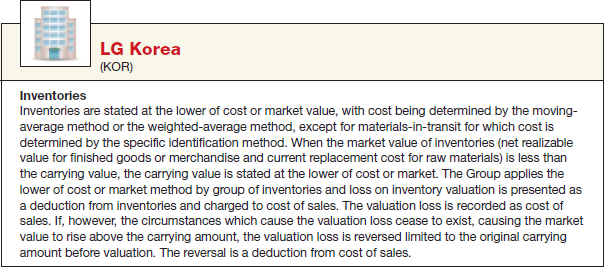
ILLUSTRATION 5-31
Accounting Policies—Intangible Asset

ILLUSTRATION 5-32
Accounting Policies—Property, Plant, and Equipment
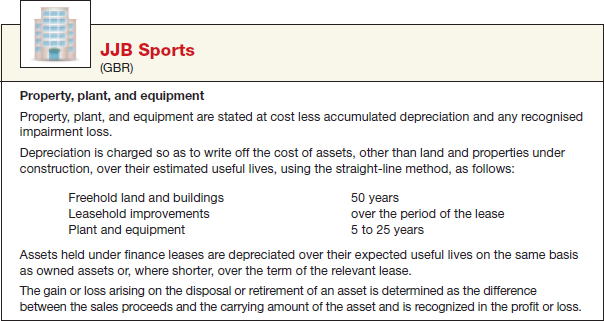
ILLUSTRATION 5-33
Accounting Policies—Financial Liabilities
Additional Notes to the Financial Statements
In addition to a note related to explanation of the companies' accounting policies, companies use specific notes to discuss items in the financial statements. Judgment must be exercised to identify the important aspects of financial information that need amplification in the notes. In many cases, IFRS requires specific disclosures. For example, using the statement of financial position as an example, note disclosures include:
- 1. Items of property, plant, and equipment are disaggregated into classes such as land, buildings, etc., in the notes, with related accumulated depreciation reported where applicable.
- 2. Receivables are disaggregated into amounts receivable from trade customers, receivables from related parties, prepayments, and other amounts.
- 3. Inventories are disaggregated into classifications such as merchandise, production supplies, work in process, and finished goods.
- 4. Provisions are disaggregated into provisions for employee benefits and other items.
In addition, there are often schedules and computations required by a specific standard. For example, for receivables, IFRS requires a maturity analysis for receivables. Illustration 5-34 shows a maturity analysis for Cadbury plc (GBR).
ILLUSTRATION 5-34
Maturity Analysis for Receivables
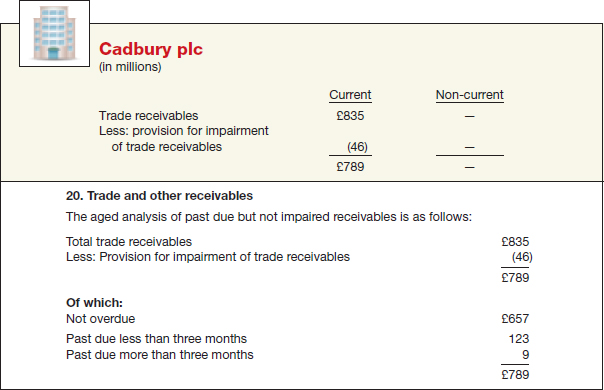
Another maturity analysis is required for financial liabilities. Illustration 5-35 shows such an analysis for Christian Dior (FRA).
ILLUSTRATION 5-35
Maturity Analysis for Financial Liabilities
Also, companies are required to reconcile the balances for many of the assets and liabilities reported in the financial statements from the beginning to the end of the year. For example, a reconciliation of the balances in property, plant, and equipment; intangible assets; and provisions are generally provided. An example for property, plant, and equipment for Nestlé (CHE) is shown in Illustration 5-36.
ILLUSTRATION 5-36
Reconciliation Schedule for Property, Plant, and Equipment
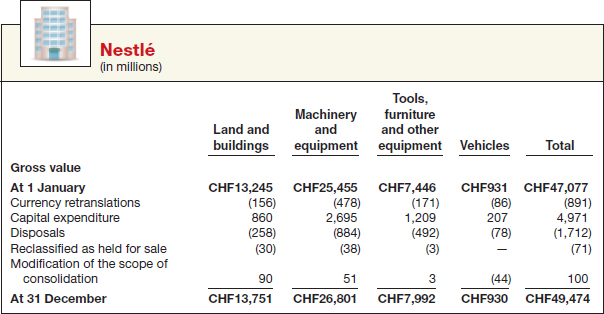
Note disclosure is extensive using IFRS. Many companies' annual reports are substantial in nature, and it is not unusual for a large company to have over 20 pages of notes to the financial statements.
Techniques of Disclosure
![]() LEARNING OBJECTIVE
LEARNING OBJECTIVE
Describe the major disclosure techniques for financial statements.
Companies should disclose as completely as possible the effect of various uncertainties on financial condition, the methods of valuing assets and liabilities, and the company's contracts and agreements. To disclose this pertinent information, companies may use parenthetical explanations and cross-reference and contra items.
Parenthetical Explanations
Companies often provide additional information by parenthetical explanations following the item. For example, Illustration 5-37 shows a parenthetical explanation of the number of shares issued by Cadbury plc (GBR) on the statement of financial position under “Equity.”
ILLUSTRATION 5-37
Parenthetical Disclosure of Shares Issued

This additional pertinent statement of financial position information adds clarity and completeness. It has an advantage over a note because it brings the additional information into the body of the statement where readers will less likely overlook it. Companies, however, should avoid lengthy parenthetical explanations, which might be distracting.
Cross-Reference and Contra Items
Companies “cross-reference” a direct relationship between an asset and a liability on the statement of financial position. For example, as shown in Illustration 5-38, on December 31, 2015, a company might show the following entries—one listed among the current assets, and the other listed among the current liabilities.
ILLUSTRATION 5-38
Cross-Referencing and Contra Items

This cross-reference points out that the company will redeem $2,300,000 of bonds payable currently, for which it has only set aside $800,000. Therefore, it needs additional cash from unrestricted cash, from sales of investments, from profits, or from some other source. Alternatively, the company can show the same information parenthetically.
Another common procedure is to establish contra or adjunct accounts. A contra account on a statement of financial position reduces either an asset, liability, or equity account. Examples include Accumulated Depreciation and Allowance for Doubtful Accounts. Contra accounts provide some flexibility in presenting the financial information. With the use of the Accumulated Depreciation account, for example, a reader of the statement can see the original cost of the asset as well as the depreciation to date.
An adjunct account, on the other hand, increases either an asset, liability, or equity account. An example is Fair Value Adjustment, which, when added to the Non-Trading Equity Investment account, describes the total investment asset of the company.
Other Guidelines
In addition to the specifics related to individual financial statements and notes to these statements, IAS No. 1 also addresses important issues related to presentation. [9]
Offsetting
IAS No. 1 indicates that it is important that assets and liabilities, and income and expense, be reported separately. Otherwise, it may be difficult for users to understand the transactions or events that occurred at the company. Therefore, it is improper for a company like Sinopec (CHN) to offset accounts payable against cash. Similarly, it is improper for Sinopec to offset debt used to purchase buildings against the buildings on the statement of financial position. However, it is proper for Sinopec to measure assets net of valuation allowances, such as allowance for doubtful accounts or inventory net of impairment. In these cases, the company is simply reporting the appropriate value on the financial statement, and therefore it is not considered offsetting. In general, unless a specific IFRS permits offsetting, it is not permitted.
Consistency
The Conceptual Framework discussed in Chapter 2 notes that one of the enhancing qualitative characteristics is comparability. As part of comparability, the Conceptual Framework indicates that companies should follow consistent principles and methods from one period to the next. [10] As a result, accounting policies must be consistently applied for similar transactions and events unless an IFRS requires a different policy. Thus, Woolworths (AUS), which uses the straight-line method for depreciating property, plant, and equipment, reports on the straight-line method for all periods presented.
Fair Presentation
Companies must present fairly the financial position, financial performance, and cash flows of the company. Fair presentation means the faithful representation of transactions and events using the definitions and recognition criteria in the Conceptual Framework. It is presumed that the use of IFRS with appropriate disclosure results in financial statements that are fairly presented. In other words, inappropriate use of accounting policies cannot be overcome by explanatory notes to the financial statements.
In some rare cases, as indicated in Chapter 2, companies can use a “true and fair” override. This situation develops, for example, when the IFRS for a given company appears to conflict with the objective of financial reporting. This situation might occur when a regulatory body indicates that a specific IFRS may be misleading. As indicated earlier, a true and fair override is highly unlikely in today's reporting environment.9
![]() Evolving Issue STATEMENT OF FINANCIAL POSITION REPORTING: GROSS OR NET?
Evolving Issue STATEMENT OF FINANCIAL POSITION REPORTING: GROSS OR NET?
In addition to the issue of financial statement presentation discussed in the opening story, a second area of controversy for statement of financial position reporting is the issue of offsetting (or netting) of assets and liabilities. It is generally accepted that offsetting of recognized assets and recognized liabilities detracts from the ability of users both to understand the transactions and conditions that have occurred and to assess the company's future cash flows. In other words, providing information on assets, liabilities, and equity helps users to compute rates of return and evaluate capital structure. However, netting assets and liabilities limits a user's ability to assess the future economic benefits and obligations.
That is, offsetting hides the existence of assets and liabilities, making it difficult to evaluate liquidity, solvency, and financial flexibility. As a result, U.S. GAAP does not permit the reporting of summary accounts alone (e.g., total assets, net assets, and total liabilities). Recently, the IASB and FASB have worked to develop common criteria for offsetting on the statement of financial position. Current offsetting rules under IFRS are more restrictive than under U.S. GAAP. The rules proposed would allow offsetting only in rare circumstances (e.g., when right of offset is legally enforceable).
Implementation of these new rules in the United States would result in a dramatic “grossing up” of statements of financial position (particularly for financial institutions). For example, one study estimated that the new rules would gross up U.S. banks' statements of financial position by $900 billion (or an average of 68%, ranging from a 31.4% increase for Citigroup to 104.7% for Morgan Stanley).* Not surprisingly, the FASB received significant push-back from some of its constituents (particularly financial institutions) to the proposed rules. The U.S. banks feared the new rules could place them in a less-favorable light when compared to their international counterparts, such as Deutsche Bank (DEU) and BNP Paribas (FRA). As a result, to date the Boards have not been able to agree on a converged standard, thereby stalling this project.
However, the Boards have issued converged disclosure requirements. The disclosure rules require companies to disclose both gross information and net information about instruments and transactions that are eligible for offset in the statement of financial position. While the Boards have not been able to develop a converged set of criteria for offsetting, the information provided under the new converged disclosure rules should enable users of a company's financial statements to evaluate the effects of netting arrangements on its financial position. In doing so, the new rules support the full disclosure principle.
*See Y. N'Diaye, “S&P: Accounting Rule Could Boost Bank Balance Sheets by Average 68%,” https://mninews.deutsche-boerse.com (September 22, 2011).
STATEMENT OF FINANCIAL POSITION AND STATEMENT OF CASH FLOWS
As in IFRS, the statement of financial position and the statement of cash flows are required statements for U.S. GAAP. In addition, the content and presentation of a U.S. GAAP statement of financial position and cash flow statement are similar to those used for IFRS.
Relevant Facts
Following are the key similarities and differences between U.S. GAAP and IFRS related to the statement of financial position.
Similarities
- Both U.S. GAAP and IFRS allow the use of the title “balance sheet” or “statement of financial position.” IFRS recommends but does not require the use of the title “statement of financial position” rather than balance sheet.
- Both U.S. GAAP and IFRS require disclosures about (1) accounting policies followed, (2) judgments that management has made in the process of applying the entity's accounting policies, and (3) the key assumptions and estimation uncertainty that could result in a material adjustment to the carrying amounts of assets and liabilities within the next financial year. Comparative prior period information must be presented and financial statements must be prepared annually.
- U.S. GAAP and IFRS require presentation of non-controlling interests in the equity section of the statement of financial position.
Differences
- U.S. GAAP follows the same guidelines as presented in the chapter for distinguishing between current and non-current assets and liabilities. However, under U.S. GAAP, public companies must follow U.S. SEC regulations, which require specific line items. In addition, specific U.S. GAAP mandates certain forms of reporting for this information. IFRS requires a classified statement of financial position except in very limited situations.
- Under U.S. GAAP cash is listed first, but under IFRS it is many times listed last. That is, under IFRS, current assets are usually listed in the reverse order of liquidity than under U.S. GAAP.
- U.S. GAAP has many differences in terminology that you will notice in this textbook. One example is the use of common stock under U.S. GAAP, which is referred to as share capital—ordinary under IFRS.
- Use of the term “reserve” is discouraged in U.S. GAAP, but there is no such prohibition in IFRS.
About the Numbers
The order of presentation in the statement of financial position differs between U.S. GAAP and IFRS. As indicated in the following table, U.S. companies generally present current assets, non-current assets, current and non-current liabilities, and shareholders' equity.
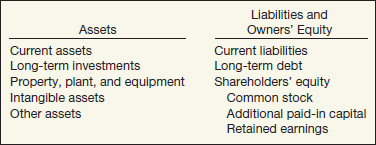
In addition, within the current asset and liability classifications, items are presented in order of liquidity, as indicated in the following excerpt from Hasbro, Inc. (USA).
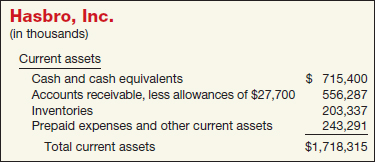
On the Horizon
The IASB and the FASB are working on a project to converge their standards related to financial statement presentation. A key feature of the proposed framework is that each of the statements will be organized, in the same format, to separate an entity's financing activities from its operating and investing activities and, further, to separate financing activities into transactions with owners and creditors. Thus, the same classifications used in the statement of financial position would also be used in the statement of comprehensive income and the statement of cash flows. The project has three phases. You can follow the joint financial presentation project at the following link: http://www.ifrs.org/Current-Projects/IASB-Projects/Financial-Statement-Presentation/Pages/Financial-Statement-Presentation.aspx.
KEY TERMS
account form, 194
accounting policies, 204
accumulated other comprehensive income, 191
adjunct account, 208
balance sheet, 182
cash debt coverage, 203
comparative information, 204
contra account, 208
current assets, 187
current cash debt coverage, 202
current liabilities, 193
equity (shareholders), 184, 191
financial flexibility, 182
financial instrument, 186 (n)
financing activities, 197
free cash flow, 203
held-for-collection securities, 185
intangible assets, 186
investing activities, 197
liquidity, 182
long-term investments, 185
non-controlling interest (minority interest), 191
non-current assets, 184
non-current liabilities, 192
non-trading equity securities, 185
operating activities, 197
property, plant, and equipment, 185
report form, 194
retained earnings, 191
share capital, 191
share premium, 191
solvency, 182
statement of cash flows, 196
statement of financial position, 182
trading securities, 185
treasury shares, 191
working capital, 194
SUMMARY OF LEARNING OBJECTIVES
![]() Explain the uses and limitations of a statement of financial position. The statement of financial position provides information about the nature and amounts of investments in a company's resources, obligations to creditors, and equity. The statement of financial position contributes to financial reporting by providing a basis for (1) computing rates of return, (2) evaluating the capital structure of the enterprise, and (3) assessing the liquidity, solvency, and financial flexibility of the enterprise.
Explain the uses and limitations of a statement of financial position. The statement of financial position provides information about the nature and amounts of investments in a company's resources, obligations to creditors, and equity. The statement of financial position contributes to financial reporting by providing a basis for (1) computing rates of return, (2) evaluating the capital structure of the enterprise, and (3) assessing the liquidity, solvency, and financial flexibility of the enterprise.
Three limitations of a statement of financial position are as follows. (1) The statement of financial position generally does not reflect fair value because accountants use a historical cost basis in valuing and reporting most assets and liabilities. (2) Companies must use judgments and estimates to determine certain amounts, such as the collectibility of receivables and the useful life of long-term tangible and intangible assets. (3) The statement of financial position omits many items that are of financial value to the business but cannot be recorded objectively, such as human resources, customer base, and reputation.
![]() Identify the major classifications of the statement of financial position. The general elements of the statement of financial position are assets, equity, and liabilities. The major classifications of assets are non-current assets; long-term investments; property, plant, and equipment; intangible assets; other assets; and current assets. The major classifications of liabilities are non-current and current liabilities. The statement of financial position of a corporation generally classifies equity as share capital, share premium, and retained earnings.
Identify the major classifications of the statement of financial position. The general elements of the statement of financial position are assets, equity, and liabilities. The major classifications of assets are non-current assets; long-term investments; property, plant, and equipment; intangible assets; other assets; and current assets. The major classifications of liabilities are non-current and current liabilities. The statement of financial position of a corporation generally classifies equity as share capital, share premium, and retained earnings.
![]() Prepare a classified statement of financial position using the report and account formats. The report form lists equity and liabilities directly below assets on the same page. The account form lists assets, by sections, on the left side, and equity and liabilities, by sections, on the right side.
Prepare a classified statement of financial position using the report and account formats. The report form lists equity and liabilities directly below assets on the same page. The account form lists assets, by sections, on the left side, and equity and liabilities, by sections, on the right side.
![]() Indicate the purpose of the statement of cash flows. The primary purpose of a statement of cash flows is to provide relevant information about a company's cash receipts and cash payments during a period. Reporting the sources, uses, and net change in cash enables financial statement readers to know what is happening to a company's most liquid resource.
Indicate the purpose of the statement of cash flows. The primary purpose of a statement of cash flows is to provide relevant information about a company's cash receipts and cash payments during a period. Reporting the sources, uses, and net change in cash enables financial statement readers to know what is happening to a company's most liquid resource.
![]() Identify the content of the statement of cash flows. In the statement of cash flows, companies classify the period's cash receipts and cash payments into three different activities. (1) Operating activities: Involve the cash effects of transactions that enter into the determination of net income. (2) Investing activities: Include making and collecting loans, and acquiring and disposing of investments (both debt and equity) and of property, plant, and equipment. (3) Financing activities: Involve liability and equity items. Financing activities include (a) obtaining capital from owners and providing them with a return on their investment, and (b) borrowing money from creditors and repaying the amounts borrowed.
Identify the content of the statement of cash flows. In the statement of cash flows, companies classify the period's cash receipts and cash payments into three different activities. (1) Operating activities: Involve the cash effects of transactions that enter into the determination of net income. (2) Investing activities: Include making and collecting loans, and acquiring and disposing of investments (both debt and equity) and of property, plant, and equipment. (3) Financing activities: Involve liability and equity items. Financing activities include (a) obtaining capital from owners and providing them with a return on their investment, and (b) borrowing money from creditors and repaying the amounts borrowed.
![]() Prepare a basic statement of cash flows. The information to prepare the statement of cash flows usually comes from comparative statements of financial position, the current income statement, and selected transaction data. Companies follow four steps to prepare the statement of cash flows from these sources. (1) Determine the net cash provided by (or used in) operating activities. (2) Determine the net cash provided by (or used in) investing and financing activities. (3) Determine the change (increase or decrease) in cash during the period. (4) Reconcile the change in cash with the beginning and ending cash balances.
Prepare a basic statement of cash flows. The information to prepare the statement of cash flows usually comes from comparative statements of financial position, the current income statement, and selected transaction data. Companies follow four steps to prepare the statement of cash flows from these sources. (1) Determine the net cash provided by (or used in) operating activities. (2) Determine the net cash provided by (or used in) investing and financing activities. (3) Determine the change (increase or decrease) in cash during the period. (4) Reconcile the change in cash with the beginning and ending cash balances.
![]() Understand the usefulness of the statement of cash flows. Creditors examine the cash flow statement carefully because they are concerned about being paid. The net cash flow provided by operating activities in relation to the company's liabilities is helpful in making this assessment. Two ratios used in this regard are the current cash debt coverage and the cash debt coverage. In addition, the amount of free cash flow provides creditors and shareholders with a picture of the company's financial flexibility.
Understand the usefulness of the statement of cash flows. Creditors examine the cash flow statement carefully because they are concerned about being paid. The net cash flow provided by operating activities in relation to the company's liabilities is helpful in making this assessment. Two ratios used in this regard are the current cash debt coverage and the cash debt coverage. In addition, the amount of free cash flow provides creditors and shareholders with a picture of the company's financial flexibility.
![]() Determine additional information requiring note disclosure. In addition to a complete set of financial statements, IFRS also requires additional reporting in the notes to the financial statements. Disclosure in the notes includes (1) accounting policies and (2) expanded disclosures and detailed schedules related to such items as property, plant, and equipment; receivables; liabilities and provisions; and equity.
Determine additional information requiring note disclosure. In addition to a complete set of financial statements, IFRS also requires additional reporting in the notes to the financial statements. Disclosure in the notes includes (1) accounting policies and (2) expanded disclosures and detailed schedules related to such items as property, plant, and equipment; receivables; liabilities and provisions; and equity.
![]() Describe the major disclosure techniques for the statement of financial position. Companies use two methods to disclose pertinent information in the statement of financial position. (1) Parenthetical explanations: Parenthetical information provides additional information or description following the item. (2) Cross-reference and contra items: Companies “cross-reference” a direct relationship between an asset and a liability on the statement of financial position. IFRS also provides guidelines related to offsetting amounts (generally not permitted), consistency in application of accounting policies, and “true and fair” presentation.
Describe the major disclosure techniques for the statement of financial position. Companies use two methods to disclose pertinent information in the statement of financial position. (1) Parenthetical explanations: Parenthetical information provides additional information or description following the item. (2) Cross-reference and contra items: Companies “cross-reference” a direct relationship between an asset and a liability on the statement of financial position. IFRS also provides guidelines related to offsetting amounts (generally not permitted), consistency in application of accounting policies, and “true and fair” presentation.
APPENDIX 5A RATIO ANALYSIS—A REFERENCE
USING RATIOS TO ANALYZE PERFORMANCE
![]() LEARNING OBJECTIVE
LEARNING OBJECTIVE
Identify the major types of financial ratios and what they measure.
Analysts and other interested parties can gather qualitative information from financial statements by examining relationships between items on the statements and identifying trends in these relationships. A useful starting point in developing this information is ratio analysis.
A ratio expresses the mathematical relationship between one quantity and another. Ratio analysis expresses the relationship among pieces of selected financial statement data, in a percentage, a rate, or a simple proportion.
To illustrate, Acer Group (TWN) recently had current assets of NT$186,391 million and current liabilities of NT$149,315 million. We find the ratio between these two amounts by dividing current assets by current liabilities. The alternative means of expression are:
| Percentage: | Current assets are 125% of current liabilities. |
| Rate: | Current assets are 1.25 times as great as current liabilities. |
| Proportion: | The relationship of current assets to current liabilities is 1.25:1. |
To analyze financial statements, we classify ratios into four types, as follows.
MAJOR TYPES OF RATIOS
LIQUIDITY RATIOS. Measures of the company's short-term ability to pay its maturing obligations.
ACTIVITY RATIOS. Measures of how effectively the company uses its assets.
PROFITABILITY RATIOS. Measures of the degree of success or failure of a given company or division for a given period of time.
COVERAGE RATIOS. Measures of the degree of protection for long-term creditors and investors.
In Chapter 5, we discussed three measures related to the statement of cash flows (current cash debt coverage, cash debt coverage, and free cash flow). Throughout the remainder of the textbook, we provide ratios to help you understand and interpret the information presented in financial statements. Illustration 5A-1 presents the ratios that we will use throughout the textbook. You should find this chart helpful as you examine these ratios in more detail in the following chapters. An appendix to Chapter 24 further discusses financial statement analysis.
ILLUSTRATION 5A-1
A Summary of Financial Ratios

KEY TERMS
activity ratios, 213
coverage ratios, 213
liquidity ratios, 213
profitability ratios, 213
ratio analysis, 213
SUMMARY OF LEARNING OBJECTIVE FOR APPENDIX 5A
![]() Identify the major types of financial ratios and what they measure. Ratios express the mathematical relationship between one quantity and another, expressed as a percentage, a rate, or a proportion. Liquidity ratios measure the short-term ability to pay maturing obligations. Activity ratios measure the effectiveness of asset usage. Profitability ratios measure the success or failure of an enterprise. Coverage ratios measure the degree of protection for long-term creditors and investors.
Identify the major types of financial ratios and what they measure. Ratios express the mathematical relationship between one quantity and another, expressed as a percentage, a rate, or a proportion. Liquidity ratios measure the short-term ability to pay maturing obligations. Activity ratios measure the effectiveness of asset usage. Profitability ratios measure the success or failure of an enterprise. Coverage ratios measure the degree of protection for long-term creditors and investors.
Authoritative Literature References
[1] International Accounting Standard 1, Presentation of Financial Statements (London, U.K.: International Accounting Standards Committee Foundation, 2005), par. BC 16.
[2] International Accounting Standard 1, Presentation of Financial Statements (London, U.K.: International Accounting Standards Committee Foundation, 2005), par. 60.
[3] International Accounting Standard 39, Financial Instruments: Recognition and Measurement (London, U.K.: International Accounting Standards Committee Foundation, 2003), paras. 43–46.
[4] International Accounting Standard 32, Financial Instruments: Presentation (London, U.K.: International Accounting Standards Committee Foundation, December 2003), par. 11.
[5] International Accounting Standard 39, Financial Instruments: Recognition and Measurement (London, U.K.: International Accounting Standards Committee Foundation, 2003), par. 9b.
[6] International Accounting Standard 1, Presentation of Financial Statements (London, U.K.: International Accounting Standards Committee Foundation, September 2005), par. 72.
[7] International Accounting Standard 1, Presentation of Financial Statements (London, U.K.: International Accounting Standards Committee Foundation, September 2005), par. 10d.
[8] International Accounting Standard 1, Presentation of Financial Statements (London, U.K.: International Accounting Standards Committee Foundation, September 2005), par. 10.
[9] International Accounting Standard 1, Presentation of Financial Statements (London, U.K.: International Accounting Standards Committee Foundation, December 2005).
[10] International Accounting Standard 8, Accounting Policies, Changes in Accounting Estimates and Errors (London, U.K.: International Accounting Standards Committee Foundation, 2003).
![]()
- How does information from the statement of financial position help users of the financial statements?
- What is meant by solvency? What information in the statement of financial position can be used to assess a company's solvency?
- A financial magazine indicated that the airline industry has poor financial flexibility. What is meant by financial flexibility, and why is it important?
- Discuss at least two situations in which estimates could affect the usefulness of information in the statement of financial position.
- Perez Company reported an increase in inventories in the past year. Discuss the effect of this change on the current ratio (current assets ÷ current liabilities). What does this tell a statement user about Perez Company's liquidity?
- What is meant by liquidity? Rank the following assets from one to five in order of liquidity.
- (a) Goodwill.
- (b) Inventory.
- (c) Buildings.
- (d) Short-term investments.
- (e) Accounts receivable.
- What are the major limitations of the statement of financial position as a source of information?
- Discuss at least two items that are important to the value of companies like Louis Vuitton (LVMH Group) (FRA) or adidas (DEU) but that are not recorded in their statements of financial position. What are some reasons why these items are not recorded in the statement of financial position?
- How does separating current assets from property, plant, and equipment in the statement of financial position help analysts?
- In its December 31, 2015, statement of financial position, Oakley Corporation reported as an asset, “Net notes and accounts receivable, €7,100,000.” What other disclosures are necessary?
- Should non-trading equity securities always be reported as a current asset? Explain.
- What is the relationship between current assets and current liabilities?
- Manchester United, Inc. sold 10,000 season tickets at £2,000 each. By December 31, 2015, 8 of the 20 home games had been played. What amount should be reported as a current liability at December 31, 2015?
- What is working capital? How does working capital relate to the operating cycle?
- In what section of the statement of financial position should the following items appear, and what statement of financial position terminology would you use?
- (a) Treasury shares (recorded at cost).
- (b) Checking account at bank.
- (c) Land (held as an investment).
- (d) Sinking fund.
- (e) Provision for warranties (short-term).
- (f) Copyrights.
- (g) Pension fund assets.
- (h) Share capital—ordinary.
- (i) Long-term investments (pledged against bank loans payable).
- (j) Non-controlling interest (minority interest).
- Where should the following items be shown on the statement of financial position, if shown at all?
- (a) Allowance for doubtful accounts.
- (b) Merchandise held on consignment.
- (c) Advances received on sales contract.
- (d) Accumulated other comprehensive income.
- (e) Land.
- (f) Merchandise out on consignment.
- (g) Franchises.
- (h) Accumulated depreciation of plant and equipment.
- (i) Materials in transit—purchased f.o.b. destination.
- State the usual basis of valuation of each of the following assets.
- (a) Trade accounts receivable.
- (b) Land.
- (c) Inventory.
- (d) Trading securities (ordinary shares of other companies).
- (e) Prepaid expenses.
- Refer to the definition of assets on page 184. Discuss how a leased building might qualify as an asset of the lessee (tenant) under this definition.
- Kathleen Battle says, “Retained earnings should be reported as an asset, since it is earnings which are reinvested in the business.” How would you respond to Battle?
- The creditors of Chan Ho Company agree to accept promissory notes for the amount of its indebtedness with a condition that two-thirds of the annual profits must be applied to their liquidation. How should these notes be reported on the statement of financial position of the issuing company? Give a reason for your answer.
- What is the purpose of a statement of cash flows? How does it differ from a statement of financial position and a statement of comprehensive income?
- The net income for the year for Genesis, Inc. is £750,000, but the statement of cash flows reports that net cash provided by operating activities is £640,000. What might account for the difference?
- Net income for the year for Carrie, Inc. was $750,000, but the statement of cash flows reports that net cash provided by operating activities was $860,000. What might account for the difference?
- Differentiate between operating activities, investing activities, and financing activities.
- Each of the following items must be considered in preparing a statement of cash flows. Indicate where each item is to be reported in the statement, if at all. Assume that net income is reported as ¥90,000 (amounts in thousands).
- (a) Accounts receivable increased from ¥34,000 to ¥39,000 from the beginning to the end of the year.
- (b) During the year, 10,000 ordinary shares with a par value of ¥100 per share were issued at ¥115 per share.
- (c) Depreciation expense amounted to ¥14,000, and intangible asset amortization amounted to ¥5,000.
- (d) Land increased from ¥10,000 to ¥30,000 due to purchase through issuance of long-term debt.
- Sergey Co. has net cash provided by operating activities of €1,200,000. Its average current liabilities for the period are €1,000,000, and its average total liabilities are €1,500,000. Comment on the company's liquidity and financial flexibility given this information.
- Net income for the year for Tanizaki, Inc. was $750,000, but the statement of cash flows reports that net cash provided by operating activities was $860,000. Tanizaki also reported capital expenditures of $75,000 and paid dividends in the amount of $30,000. Compute Tanizaki's free cash flow.
- What is the purpose of a free cash flow analysis?
- What is a “Summary of Significant Accounting Policies”?
- What are some of the techniques of disclosure for financial statement information?
- Briefly describe some of the similarities and differences between IFRS and U.S. GAAP with respect to statement of financial position reporting.

- Briefly describe the convergence efforts related to financial statement presentation.

- Rainmaker Company prepares its financial statements in accordance with U.S. GAAP. Briefly discuss the differences in order of presentation in its statement of financial position compared to IFRS.

![]() BE5-1 Harding Corporation has the following accounts included in its December 31, 2015, trial balance: Accounts Receivable €110,000, Inventory €290,000, Allowance for Doubtful Accounts €8,000, Patents €72,000, Prepaid Insurance €9,500, Accounts Payable €77,000, and Cash €30,000. Prepare the current assets section of the statement of financial position, listing the accounts in the sequence shown in the chapter.
BE5-1 Harding Corporation has the following accounts included in its December 31, 2015, trial balance: Accounts Receivable €110,000, Inventory €290,000, Allowance for Doubtful Accounts €8,000, Patents €72,000, Prepaid Insurance €9,500, Accounts Payable €77,000, and Cash €30,000. Prepare the current assets section of the statement of financial position, listing the accounts in the sequence shown in the chapter.
![]() BE5-2 Koch Corporation's adjusted trial balance contained the following asset accounts at December 31, 2015: Cash €7,000, Land €40,000, Patents €12,500, Accounts Receivable €90,000, Prepaid Insurance €5,200, Inventory €30,000, Allowance for Doubtful Accounts €4,000, and Trading Securities €11,000. Prepare the current assets section of the statement of financial position, listing the accounts in the sequence shown in the chapter.
BE5-2 Koch Corporation's adjusted trial balance contained the following asset accounts at December 31, 2015: Cash €7,000, Land €40,000, Patents €12,500, Accounts Receivable €90,000, Prepaid Insurance €5,200, Inventory €30,000, Allowance for Doubtful Accounts €4,000, and Trading Securities €11,000. Prepare the current assets section of the statement of financial position, listing the accounts in the sequence shown in the chapter.
![]() BE5-3 Included in Outkast Company's December 31, 2015, trial balance are the following accounts: Prepaid Rent $5,200, Held-for-Collection Securities $56,000, Unearned Service Revenue $17,000, Land Held for Investment $39,000, and Notes Receivable (long-term) $42,000. Prepare the long-term investments section of the statement of financial position.
BE5-3 Included in Outkast Company's December 31, 2015, trial balance are the following accounts: Prepaid Rent $5,200, Held-for-Collection Securities $56,000, Unearned Service Revenue $17,000, Land Held for Investment $39,000, and Notes Receivable (long-term) $42,000. Prepare the long-term investments section of the statement of financial position.
![]() BE5-4 Lowell Company's December 31, 2015, trial balance includes the following accounts: Inventory $120,000, Buildings $207,000, Accumulated Depreciation–Equipment $19,000, Equipment $190,000, Land Held for Investment $46,000, Accumulated Depreciation–Buildings $45,000, and Land $71,000. Prepare the property, plant, and equipment section of the statement of financial position.
BE5-4 Lowell Company's December 31, 2015, trial balance includes the following accounts: Inventory $120,000, Buildings $207,000, Accumulated Depreciation–Equipment $19,000, Equipment $190,000, Land Held for Investment $46,000, Accumulated Depreciation–Buildings $45,000, and Land $71,000. Prepare the property, plant, and equipment section of the statement of financial position.
![]() BE5-5 Crane Corporation has the following accounts included in its December 31, 2015, trial balance: Trading Securities £21,000, Goodwill £150,000, Prepaid Insurance £12,000, Patents £220,000, and Franchises £130,000. Prepare the intangible assets section of the statement of financial position.
BE5-5 Crane Corporation has the following accounts included in its December 31, 2015, trial balance: Trading Securities £21,000, Goodwill £150,000, Prepaid Insurance £12,000, Patents £220,000, and Franchises £130,000. Prepare the intangible assets section of the statement of financial position.
![]() BE5-6 Patrick Corporation's adjusted trial balance contained the following asset accounts at December 31, 2015: Capitalized Development Costs $18,000, Prepaid Rent $12,000, Goodwill $50,000, Franchise Fees Receivable $2,000, Franchises $47,000, Patents $33,000, and Trademarks $10,000. Prepare the intangible assets section of the statement of financial position.
BE5-6 Patrick Corporation's adjusted trial balance contained the following asset accounts at December 31, 2015: Capitalized Development Costs $18,000, Prepaid Rent $12,000, Goodwill $50,000, Franchise Fees Receivable $2,000, Franchises $47,000, Patents $33,000, and Trademarks $10,000. Prepare the intangible assets section of the statement of financial position.
![]() BE5-7 Thomas Corporation's adjusted trial balance contained the following liability accounts at December 31, 2015. Bonds Payable (due in 3 years) $100,000, Accounts Payable $72,000, Notes Payable (due in 90 days) $22,500, Salaries and Wages Payable $4,000, and Income Taxes Payable $7,000. Prepare the current liabilities section of the statement of financial position.
BE5-7 Thomas Corporation's adjusted trial balance contained the following liability accounts at December 31, 2015. Bonds Payable (due in 3 years) $100,000, Accounts Payable $72,000, Notes Payable (due in 90 days) $22,500, Salaries and Wages Payable $4,000, and Income Taxes Payable $7,000. Prepare the current liabilities section of the statement of financial position.
![]() BE5-8 Included in Arco Company's December 31, 2015, trial balance are the following accounts: Accounts Payable
BE5-8 Included in Arco Company's December 31, 2015, trial balance are the following accounts: Accounts Payable ![]() 220,000, Pension Liability
220,000, Pension Liability ![]() 375,000, Advances from Customers
375,000, Advances from Customers ![]() 41,000, Bonds Payable
41,000, Bonds Payable ![]() 371,000, Salaries and Wages Payable
371,000, Salaries and Wages Payable ![]() 27,000, Interest Payable
27,000, Interest Payable ![]() 12,000, Income Taxes Payable
12,000, Income Taxes Payable ![]() 29,000, and Provision for Warranties (current
29,000, and Provision for Warranties (current ![]() 3,000, non-current
3,000, non-current ![]() 6,000). Prepare the current liabilities section of the statement of financial position.
6,000). Prepare the current liabilities section of the statement of financial position.
![]() BE5-9 Use the information presented in BE5-8 for Arco Company to prepare the non-current liabilities section of the statement of financial position.
BE5-9 Use the information presented in BE5-8 for Arco Company to prepare the non-current liabilities section of the statement of financial position.
![]() BE5-10 Hawthorn Corporation's adjusted trial balance contained the following accounts at December 31, 2015: Retained Earnings €120,000, Share Capital—Ordinary €750,000, Bonds Payable €100,000, Share Premium—Ordinary €200,000, Goodwill €55,000, Accumulated Other Comprehensive Income €(150,000), and Non-Controlling Interest €80,000. Prepare the equity section of the statement of financial position.
BE5-10 Hawthorn Corporation's adjusted trial balance contained the following accounts at December 31, 2015: Retained Earnings €120,000, Share Capital—Ordinary €750,000, Bonds Payable €100,000, Share Premium—Ordinary €200,000, Goodwill €55,000, Accumulated Other Comprehensive Income €(150,000), and Non-Controlling Interest €80,000. Prepare the equity section of the statement of financial position.
![]() BE5-11 Stowe Company's December 31, 2015, trial balance includes the following accounts: Share Capital—Ordinary €70,000, Retained Earnings €114,000, Trademarks €31,000, Share Capital—Preference €152,000, Trading Securities €55,000, Deferred Income Taxes €88,000, Share Premium—Ordinary €174,000, and Non-Controlling Interest €18,000. Prepare the equity section of the statement of financial position.
BE5-11 Stowe Company's December 31, 2015, trial balance includes the following accounts: Share Capital—Ordinary €70,000, Retained Earnings €114,000, Trademarks €31,000, Share Capital—Preference €152,000, Trading Securities €55,000, Deferred Income Taxes €88,000, Share Premium—Ordinary €174,000, and Non-Controlling Interest €18,000. Prepare the equity section of the statement of financial position.
![]() BE5-12 Keyser Beverage Company reported the following items in the most recent year.
BE5-12 Keyser Beverage Company reported the following items in the most recent year.

Compute net cash provided by operating activities, the net change in cash during the year, and free cash flow.
![]() BE5-13 Ames Company reported 2015 net income of HK$151,000. During 2015, accounts receivable increased by HK$13,000 and accounts payable increased by HK$9,500. Depreciation expense was HK$44,000. Prepare the cash flows from operating activities section of the statement of cash flows (amounts in thousands).
BE5-13 Ames Company reported 2015 net income of HK$151,000. During 2015, accounts receivable increased by HK$13,000 and accounts payable increased by HK$9,500. Depreciation expense was HK$44,000. Prepare the cash flows from operating activities section of the statement of cash flows (amounts in thousands).
![]() BE5-14 Martinez Corporation engaged in the following cash transactions during 2015.
BE5-14 Martinez Corporation engaged in the following cash transactions during 2015.

Compute the net cash provided (used) by investing activities.
![]() BE5-15 Use the information presented in BE5-14 for Martinez Corporation to compute the net cash provided (used) by financing activities.
BE5-15 Use the information presented in BE5-14 for Martinez Corporation to compute the net cash provided (used) by financing activities.
![]() BE5-16 Using the information in BE5-14, determine Martinez's free cash flow, assuming that it reported net cash provided by operating activities of R$400,000.
BE5-16 Using the information in BE5-14, determine Martinez's free cash flow, assuming that it reported net cash provided by operating activities of R$400,000.
![]()
![]() E5-1 (Statement of Financial Position Classifications) Presented below are a number of statement of financial position accounts of Cunningham, Inc.
E5-1 (Statement of Financial Position Classifications) Presented below are a number of statement of financial position accounts of Cunningham, Inc.
- (a) Investment in Preference Shares.
- (b) Treasury Shares.
- (c) Share Capital—Ordinary.
- (d) Dividends Payable.
- (e) Accumulated Depreciation—Equipment
- (f) Construction in Process.
- (g) Petty Cash.
- (h) Interest Payable.
- (i) Deficit.
- (j) Trading Securities.
- (k) Income Taxes Payable.
- (l) Unearned Service Revenue.
- (m) Work in Process.
- (n) Salaries and Wages Payable.
Instructions
For each of the accounts above, indicate the proper statement of financial position classification. In the case of borderline items, indicate the additional information that would be required to determine the proper classification.
![]() E5-2 (Classification of Statement of Financial Position Accounts) Presented below are the captions of Nikos Company's statement of financial position.
E5-2 (Classification of Statement of Financial Position Accounts) Presented below are the captions of Nikos Company's statement of financial position.
- (a) Non-current assets.
- (1) Investments.
- (2) Property, plant, and equipment.
- (3) Intangible assets.
- (4) Other assets.
- (b) Current assets.
- (c) Equity.
- (d) Non-current liabilities.
- (e) Current liabilities.
Instructions
Indicate by letter where each of the following items would be classified.
- 1. Share capital—preference.
- 2. Goodwill.
- 3. Salaries and wages payable.
- 4. Accounts payable.
- 5. Buildings.
- 6. Trading securities.
- 7. Current portion of long-term debt.
- 8. Patents.
- 9. Allowance for doubtful accounts.
- 10. Accounts receivable.
- 11. Accumulated other comprehensive income.
- 12. Notes payable (due next year).
- 13. Supplies.
- 14. Share capital—ordinary.
- 15. Land.
- 16. Bond sinking fund.
- 17. Inventory.
- 18. Prepaid insurance.
- 19. Bonds payable.
- 20. Income taxes payable.
![]() E5-3 (Classification of Statement of Financial Position Accounts) Assume that Masters Enterprises uses the following headings on its statement of financial position.
E5-3 (Classification of Statement of Financial Position Accounts) Assume that Masters Enterprises uses the following headings on its statement of financial position.
- (a) Investments.
- (b) Property, plant, and equipment.
- (c) Intangible assets.
- (d) Other assets.
- (e) Current assets.
- (f) Non-current liabilities.
- (g) Current liabilities.
- (h) Share capital.
- (i) Share premium.
- (j) Retained earnings.
- (k) Accumulated other comprehensive income.
Instructions
Indicate by letter how each of the following usually should be classified. If an item should appear in a note to the financial statements, use the letter “N” to indicate this fact. If an item need not be reported at all on the statement of financial position, use the letter “X.”
- 1. Prepaid insurance.
- 2. Shares owned in associated companies.
- 3. Unearned service revenue.
- 4. Advances to suppliers.
- 5. Unearned rent revenue.
- 6. Share capital—preference.
- 7. Share premium—preference.
- 8. Copyrights.
- 9. Petty cash fund.
- 10. Sales taxes payable.
- 11. Interest on notes receivable.
- 12. Twenty-year bonds payable that will mature within the next year. (No sinking fund exists, and refunding is not planned.)
- 13. Accounts receivable.
- 14. Unrealized gain on non-trading equity securities.
- 15. Interest on bonds payable.
- 16. Salaries that company budget shows will be paid to employees within the next year.
- 17. Accumulated depreciation—equipment.
![]() E5-4 (Preparation of a Classified Statement of Financial Position) Assume that Gulistan Inc. has the following accounts at the end of the current year.
E5-4 (Preparation of a Classified Statement of Financial Position) Assume that Gulistan Inc. has the following accounts at the end of the current year.
- 1. Share Capital—Ordinary.
- 2. Notes Payable (long-term).
- 3. Treasury Shares (at cost).
- 4. Note Payable (short-term).
- 5. Raw Materials.
- 6. Long-Term Investment in Preference Shares.
- 7. Unearned Rent Revenue.
- 8. Work in Process.
- 9. Copyrights.
- 10. Buildings.
- 11. Notes Receivable (short-term).
- 12. Cash.
- 13. Salaries and Wages Payable.
- 14. Accumulated Depreciation—Buildings.
- 15. Cash Restricted for Plant Expansion.
- 16. Land Held for Future Plant Site.
- 17. Allowance for Doubtful Accounts (Accounts Receivable).
- 18. Retained Earnings.
- 19. Share Premium—Ordinary.
- 20. Unearned Service Revenue.
- 21. Receivables—Officers (due in 1 year).
- 22. Finished Goods.
- 23. Accounts Receivable.
- 24. Bonds Payable (due in 4 years).
Instructions
Prepare a classified statement of financial position in good form. (No monetary amounts are necessary.)
![]() E5-5 (Preparation of a Corrected Statement of Financial Position) Bruno Company has decided to expand its operations. The bookkeeper recently completed the statement of financial position shown on the next page in order to obtain additional funds for expansion.
E5-5 (Preparation of a Corrected Statement of Financial Position) Bruno Company has decided to expand its operations. The bookkeeper recently completed the statement of financial position shown on the next page in order to obtain additional funds for expansion.
Instructions
Prepare a revised statement of financial position given the available information. Assume that the accumulated depreciation balance for the buildings is €160,000 and for the equipment, €105,000. The allowance for doubtful accounts has a balance of €17,000. The pension liability is considered a non-current liability.
![]() E5-6 (Corrections of a Statement of Financial Position) The bookkeeper for Garfield Company has prepared the following statement of financial position as of July 31, 2015 (amounts in thousands).
E5-6 (Corrections of a Statement of Financial Position) The bookkeeper for Garfield Company has prepared the following statement of financial position as of July 31, 2015 (amounts in thousands).

The following additional information is provided.
- 1. Cash includes ¥1,200 in a petty cash fund and ¥12,000 in a bond sinking fund.
- 2. The net accounts receivable balance is comprised of the following three items: (a) accounts receivable—debit balances ¥52,000, (b) accounts receivable—credit balances ¥8,000, and (c) allowance for doubtful accounts ¥3,500.
- 3. Inventory costing ¥5,300 was shipped out on consignment on July 31, 2015. The ending inventory balance does not include the consigned goods. Receivables in the amount of ¥5,300 were recognized on these consigned goods.
- 4. Equipment had a cost of ¥112,000 and an accumulated depreciation balance of ¥28,000.
- 5. Income taxes payable of ¥9,000 were accrued on July 31. Liba Company, however, had set up a cash fund to meet this obligation. This cash fund was not included in the cash balance but was offset against the income taxes payable amount.
Instructions
Prepare a corrected classified statement of financial position as of July 31, 2015, from the available information, adjusting the account balances using the additional information.
![]() E5-7 (Current Assets Section of the Statement of Financial Position) Presented below are selected accounts of Aramis Company at December 31, 2015.
E5-7 (Current Assets Section of the Statement of Financial Position) Presented below are selected accounts of Aramis Company at December 31, 2015.

The following additional information is available.
- 1. Inventory is valued at lower-of-cost-or-net realizable value using FIFO.
- 2. Equipment is recorded at cost. Accumulated depreciation, computed on a straight-line basis, is €50,600.
- 3. The trading securities have a fair value of €29,000.
- 4. The notes receivable are due April 30, 2017, with interest receivable every April 30. The notes bear interest at 6%. (Hint: Accrue interest due on December 31, 2015.)
- 5. The allowance for doubtful accounts applies to the accounts receivable. Accounts receivable of €50,000 are pledged as collateral on a bank loan.
- 6. Licenses are recorded net of accumulated amortization of €14,000.
- 7. Treasury shares are recorded at cost.
Instructions
Prepare the current assets section of Aramis Company's December 31, 2015, statement of financial position, with appropriate disclosures.
![]() E5-8 (Current vs. Non-Current Liabilities) Pascal Corporation is preparing its December 31, 2015, statement of financial position. The following items may be reported as either a current or non-current liability.
E5-8 (Current vs. Non-Current Liabilities) Pascal Corporation is preparing its December 31, 2015, statement of financial position. The following items may be reported as either a current or non-current liability.
- 1. On December 15, 2015, Pascal declared a cash dividend of $2.00 per share to shareholders of record on December 31. The dividend is payable on January 15, 2016. Pascal has issued 1,000,000 ordinary shares of which 50,000 shares are held in treasury.
- 2. At December 31, bonds payable of $100,000,000 are outstanding. The bonds pay 8% interest every September 30 and mature in installments of $25,000,000 every September 30, beginning September 30, 2016.
- 3. At December 31, 2014, customer advances were $12,000,000. During 2015, Pascal collected $30,000,000 of customer advances, and advances of $25,000,000 were earned.
![]() E5-9 (Current Assets and Current Liabilities) The current assets and current liabilities sections of the statement of financial position of Jin Liu Company appear as follows (amounts in thousands).
E5-9 (Current Assets and Current Liabilities) The current assets and current liabilities sections of the statement of financial position of Jin Liu Company appear as follows (amounts in thousands).

The following errors in the corporation's accounting have been discovered:
- 1. January 2016 cash disbursements entered as of December 2015 included payments of accounts payable in the amount of ¥35,000, on which a cash discount of 2% was taken.
- 2. The inventory included ¥27,000 of merchandise that had been received at December 31 but for which no purchase invoices had been received or entered. Of this amount, ¥10,000 had been received on consignment; the remainder was purchased f.o.b. destination, terms 2/10, n/30.
- 3. Sales for the first four days in January 2016 in the amount of ¥30,000 were entered in the sales book as of December 31, 2015. Of these, ¥21,500 were sales on account and the remainder were cash sales.
- 4. Cash, not including cash sales, collected in January 2016 and entered as of December 31, 2015, totaled ¥35,324. Of this amount, ¥23,324 was received on account after cash discounts of 2% had been deducted; the remainder represented the proceeds of a bank loan.
Instructions
- (a) Restate the current assets and current liabilities sections of the statement of financial position in accordance with good accounting practice. (Assume that both accounts receivable and accounts payable are recorded gross.)
- (b) State the net effect of your adjustments on Jin Liu Company's retained earnings balance.
![]() E5-10 (Current Liabilities) Mary Pierce is the controller of Arnold Corporation and is responsible for the preparation of the year-end financial statements. The following transactions occurred during the year.
E5-10 (Current Liabilities) Mary Pierce is the controller of Arnold Corporation and is responsible for the preparation of the year-end financial statements. The following transactions occurred during the year.
- (a) Bonuses to key employees based on net income for 2015 are estimated to be $150,000.
- (b) On December 1, 2015, the company borrowed $900,000 at 8% per year. Interest is paid quarterly.
- (c) Credit sales for the year amounted to $10,000,000. Arnold's expense provision for doubtful accounts is estimated to be 2% of credit sales.
- (d) On December 15, 2015, the company declared a $2 per share dividend on the 40,000 ordinary shares outstanding, to be paid on January 5, 2016.
- (e) During the year, customer advances of $160,000 were received; $50,000 of this amount was earned by December 31, 2015.
Instructions
For each item above, indicate the dollar amount to be reported as a current liability. If a liability is not reported, explain why.
![]() E5-11 (Statement of Financial Position Preparation) Presented below is the adjusted trial balance of Abbey Corporation at December 31, 2015.
E5-11 (Statement of Financial Position Preparation) Presented below is the adjusted trial balance of Abbey Corporation at December 31, 2015.

Additional information:
- 1. Net loss for the year was £2,500.
- 2. No dividends were declared during 2015.
Instructions
Prepare a classified statement of financial position as of December 31, 2015.
![]() E5-12 (Preparation of a Statement of Financial Position) Presented below is the trial balance of Vivaldi Corporation at December 31, 2015.
E5-12 (Preparation of a Statement of Financial Position) Presented below is the trial balance of Vivaldi Corporation at December 31, 2015.
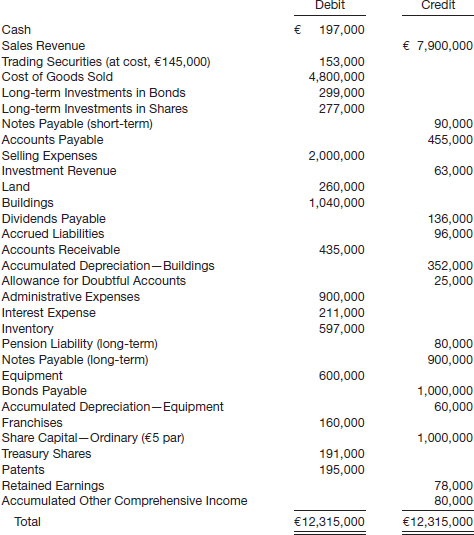
Instructions
Prepare a statement of financial position at December 31, 2015, for Vivaldi Corporation. (Ignore income taxes.)
![]() E5-13 (Statement of Cash Flows—Classifications) The major classifications of activities reported in the statement of cash flows are operating, investing, and financing. Classify each of the transactions listed below as:
E5-13 (Statement of Cash Flows—Classifications) The major classifications of activities reported in the statement of cash flows are operating, investing, and financing. Classify each of the transactions listed below as:
- 1. Operating activity—add to net income.
- 2. Operating activity—deduct from net income.
- 3. Investing activity.
- 4. Financing activity.
- 5. Reported as significant non-cash activity in the notes to the financial statements.
The transactions are as follows.
- (a) Issuance of ordinary shares.
- (b) Purchase of land and building.
- (c) Redemption of bonds.
- (d) Sale of equipment.
- (e) Depreciation of machinery.
- (f) Amortization of patent.
- (g) Issuance of bonds for plant assets.
- (h) Payment of cash dividends.
- (i) Exchange of furniture for office equipment.
- (j) Purchase of treasury shares.
- (k) Loss on sale of equipment.
- (l) Increase in accounts receivable during the year.
- (m) Decrease in accounts payable during the year.
![]() E5-14 (Preparation of a Statement of Cash Flows) The comparative statements of financial position of Lopez Inc. at the beginning and the end of the year 2015 appear on the next page.
E5-14 (Preparation of a Statement of Cash Flows) The comparative statements of financial position of Lopez Inc. at the beginning and the end of the year 2015 appear on the next page.
![]() E5-15 (Preparation of a Statement of Cash Flows) Presented below is a condensed version of the comparative statements of financial position for Yoon Corporation for the last two years at December 31 (amounts in millions).
E5-15 (Preparation of a Statement of Cash Flows) Presented below is a condensed version of the comparative statements of financial position for Yoon Corporation for the last two years at December 31 (amounts in millions).

Additional information:
Investments were sold at a loss of ![]() 7,000; no equipment was sold; cash dividends paid were
7,000; no equipment was sold; cash dividends paid were ![]() 50,000; and net income was
50,000; and net income was ![]() 160,000.
160,000.
Instructions
- (a) Prepare a statement of cash flows for 2015 for Yoon Corporation.
- (b) Determine Yoon Corporation's free cash flow.
![]() E5-16 (Preparation of a Statement of Cash Flows) A comparative statement of financial position for Orozco Corporation is presented below.
E5-16 (Preparation of a Statement of Cash Flows) A comparative statement of financial position for Orozco Corporation is presented below.
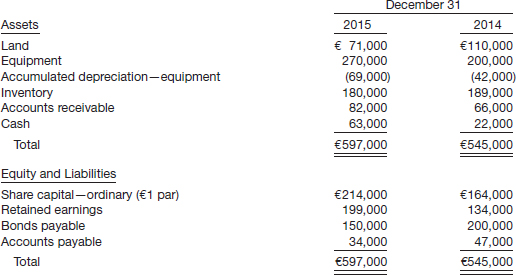
- 1. Net income for 2015 was €105,000.
- 2. Cash dividends of €40,000 were declared and paid.
- 3. Bonds payable amounting to €50,000 were retired through issuance of ordinary shares.
Instructions
- (a) Prepare a statement of cash flows for 2015 for Orozco Corporation.
- (b) Determine Orozco Corporation's current cash debt coverage, cash debt coverage, and free cash flow. Comment on its liquidity and financial flexibility.
![]() E5-17 (Preparation of a Statement of Cash Flows and a Statement of Financial Position) Chekov Corporation's statement of financial position at the end of 2014 included the following items.
E5-17 (Preparation of a Statement of Cash Flows and a Statement of Financial Position) Chekov Corporation's statement of financial position at the end of 2014 included the following items.

The following information is available for 2015.
- 1. Net income was $55,000.
- 2. Equipment (cost $20,000 and accumulated depreciation $8,000) was sold for $9,000.
- 3. Depreciation expense was $4,000 on the building and $9,000 on equipment.
- 4. Patent amortization was $2,500.
- 5. Current assets other than cash increased by $25,000. Current liabilities increased by $13,000.
- 6. An addition to the building was completed at a cost of $27,000.
- 7. A long-term investment in debt securities was purchased for $16,000.
- 8. Bonds payable of $50,000 were issued.
- 9. Cash dividends of $25,000 were declared and paid.
- 10. Treasury shares were purchased at a cost of $11,000.
Instructions
(Show only totals for current assets and current liabilities.)
- (a) Prepare a statement of cash flows for 2015.
- (b) Prepare a statement of financial position at December 31, 2015.
![]() E5-18 (Preparation of a Statement of Cash Flows, Analysis) The comparative statements of financial position of Menachem Corporation at the beginning and end of the year 2015 appear below.
E5-18 (Preparation of a Statement of Cash Flows, Analysis) The comparative statements of financial position of Menachem Corporation at the beginning and end of the year 2015 appear below.
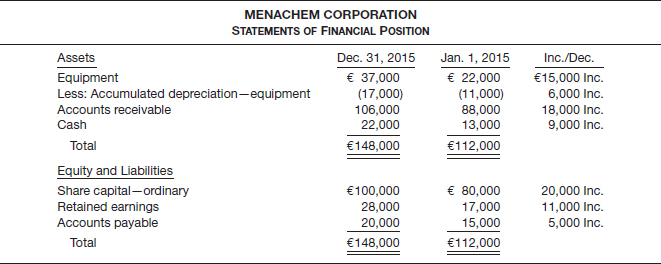
Net income of €34,000 was reported, and dividends of €23,000 were paid in 2015. New equipment was purchased and none was sold.
Instructions
- (a) Prepare a statement of cash flows for the year 2015.
- (b) Compute the current ratio (current assets ÷ current liabilities) as of January 1, 2015, and December 31, 2015, and compute free cash flow for the year 2015.
- (c) In light of the analysis in (b), comment on Menachem's liquidity and financial flexibility.
![]()
![]() P5-1 (Preparation of a Classified Statement of Financial Position, Periodic Inventory) Presented below is a list of accounts in alphabetical order.
P5-1 (Preparation of a Classified Statement of Financial Position, Periodic Inventory) Presented below is a list of accounts in alphabetical order.

Instructions
Prepare a classified statement of financial position in good form. (No monetary amounts are to be shown.)
![]() P5-2 (Statement of Financial Position Preparation) Presented below are a number of statement of financial position items for Montoya, Inc., for the current year, 2015.
P5-2 (Statement of Financial Position Preparation) Presented below are a number of statement of financial position items for Montoya, Inc., for the current year, 2015.

Instructions
Prepare a classified statement of financial position in good form. Share capital—ordinary shares authorized was 400,000 shares, and share capital—preference shares authorized was 20,000 shares. Assume that notes receivable and notes payable are short-term, unless stated otherwise. Cost and fair value of trading securities are the same.
![]() P5-3 (Statement of Financial Position Adjustment and Preparation) The adjusted trial balance of Asian-Pacific Company and other related information for the year 2015 are presented below (amounts in thousands).
P5-3 (Statement of Financial Position Adjustment and Preparation) The adjusted trial balance of Asian-Pacific Company and other related information for the year 2015 are presented below (amounts in thousands).
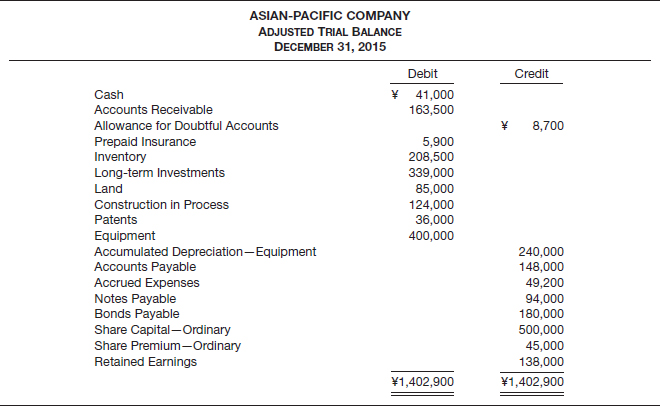
Additional information:
- 1. The average-cost method of inventory value is used.
- 2. The cost and fair value of the long-term investments that consist of ordinary shares and bonds is the same.
- 3. The amount of the Construction in Process account represents the costs expended to date on a building in the process of construction. (The company rents factory space at the present time.) The land on which the building is being constructed cost ¥85,000, as shown in the trial balance.
- 4. The patents were purchased by the company at a cost of ¥40,000 and are being amortized on a straight-line basis.
- 5. The notes payable represent bank loans that are secured by long-term investments carried at ¥120,000. These bank loans are due in 2016.
- 6. The bonds payable bear interest at 8% payable every December 31, and are due January 1, 2026.
- 7. 600,000 ordinary shares with a par value of ¥1 were authorized, of which 500,000 shares were issued and outstanding.
Instructions
Prepare a statement of financial position as of December 31, 2015, so that all important information is fully disclosed.
![]() P5-4 (Preparation of a Corrected Statement of Financial Position) Presented on the next page is the statement of financial position of Kishwaukee Corporation as of December 31, 2015.
P5-4 (Preparation of a Corrected Statement of Financial Position) Presented on the next page is the statement of financial position of Kishwaukee Corporation as of December 31, 2015.
![]()
Instructions
Prepare a corrected classified statement of financial position in good form. The notes above are for information only.
![]() P5-5 (Statement of Financial Position Adjustment and Preparation) Presented below is the statement of financial position of Sargent Corporation for the current year, 2015.
P5-5 (Statement of Financial Position Adjustment and Preparation) Presented below is the statement of financial position of Sargent Corporation for the current year, 2015.
![]()

The following information is presented.
- 1. The current assets section includes cash $150,000, accounts receivable $170,000 less $10,000 for allowance for doubtful accounts, inventory $180,000, and unearned service revenue $5,000. Inventory is stated at the lower-of-FIFO-cost-or net realizable value.
- 2. The investments section includes land held for speculation $40,000; investments in ordinary shares, short-term (trading) $80,000 and long-term (non-trading) $270,000; and bond sinking fund $250,000. The cost and fair value of investments in ordinary shares are the same.
- 3. Property, plant, and equipment includes buildings $1,040,000 less accumulated depreciation $360,000, equipment $450,000 less accumulated depreciation $180,000, land $500,000, and land held for future use $270,000.
- 4. Intangible assets include a franchise $165,000 and goodwill $100,000.
- 5. Current liabilities include accounts payable $140,000; notes payable—short-term $80,000 and long-term $120,000; and income taxes payable $40,000.
- 6. Non-current liabilities are composed solely of 7% bonds payable due 2023.
- 7. Equity has share capital—preference, $5 par value, authorized 200,000 shares, issued 90,000 shares for $450,000; and share capital—ordinary, $1 par value, authorized 400,000 shares, issued 100,000 shares at an average price of $10. In addition, the corporation has retained earnings of $320,000.
Instructions
Prepare a statement of financial position in good form, adjusting the amounts in each statement of financial position classification as affected by the information given above.
![]() P5-6 (Preparation of a Statement of Cash Flows and a Statement of Financial Position) Lansbury Inc. had the statement of financial position shown below at December 31, 2014.
P5-6 (Preparation of a Statement of Cash Flows and a Statement of Financial Position) Lansbury Inc. had the statement of financial position shown below at December 31, 2014.

During 2015, the following occurred.
- 1. Lansbury Inc. sold part of its investment portfolio for $15,000. This transaction resulted in a gain of $3,400 for the firm. The company classifies its investments as non-trading equity.
- 2. A tract of land was purchased for $18,000 cash.
- 3. Long-term notes payable in the amount of $16,000 were retired before maturity by paying $16,000 cash.
- 4. An additional $20,000 in ordinary shares were issued at par.
- 5. Dividends totalling $8,200 were declared and paid to shareholders.
- 6. Net income for 2015 was $32,000 after allowing for depreciation of $11,000.
- 7. Land was purchased through the issuance of $30,000 in bonds.
- 8. At December 31, 2015, Cash was $32,000, Accounts Receivable was $41,600, and Accounts Payable remained at $30,000.
Instructions
- (a) Prepare a statement of cash flows for 2015.
- (b) Prepare a statement of financial position as it would appear at December 31, 2015.
- (c) How might the statement of cash flows help the user of the financial statements? Compute free cash flow and two cash flow ratios.
![]() P5-7 (Preparation of a Statement of Cash Flows and Statement of Financial Position) Luo Inc. had the following statement of financial position at December 31, 2014 (amounts in thousands).
P5-7 (Preparation of a Statement of Cash Flows and Statement of Financial Position) Luo Inc. had the following statement of financial position at December 31, 2014 (amounts in thousands).
![]()

During 2015, the following occurred.
- 1. Luo liquidated its non-trading equity investment portfolio at a loss of ¥5,000.
- 2. A tract of land was purchased for ¥38,000.
- 3. An additional ¥30,000 in ordinary shares were issued at par.
- 4. Dividends totaling ¥10,000 were declared and paid to shareholders.
- 5. Net income for 2015 was ¥35,000, including ¥12,000 in depreciation expense.
- 6. Land was purchased through the issuance of ¥30,000 in additional bonds.
- 7. At December 31, 2015, Cash was ¥70,200, Accounts Receivable was ¥42,000, and Accounts Payable was ¥40,000.
Instructions
- (a) Prepare a statement of cash flows for the year 2015 for Luo.
- (b) Prepare the statement of financial position as it would appear at December 31, 2015.
- (c) Compute Luo's free cash flow and the current cash debt coverage for 2015.
- (d) Use the analysis of Luo to illustrate how information in the statement of financial position and statement of cash flows helps the user of the financial statements.
![]()
CA5-1 (Reporting the Financial Effects of Varied Transactions) In an examination of Arenes Corporation as of December 31, 2015, you have learned that the following situations exist. No entries have been made in the accounting records for these items.
- The corporation erected its present factory building in 2000. Depreciation was calculated by the straight-line method, using an estimated life of 35 years. Early in 2015, the board of directors conducted a careful survey and estimated that the factory building had a remaining useful life of 25 years as of January 1, 2015.
- When calculating the accrual for officers' salaries at December 31, 2015, it was discovered that the accrual for officers' salaries for December 31, 2014, had been overstated.
- On December 15, 2015, Arenes Corporation declared a cash dividend on its ordinary shares outstanding, payable February 1, 2016, to the shareholders of record December 31, 2015.
Instructions
Describe fully how each of the items above should be reported in the financial statements of Arenes Corporation for the year 2015.
CA5-2 (Current Asset and Liability Classification) Below are the titles of a number of debit and credit accounts as they might appear on the statement of financial position of Hayduke Corporation as of October 31, 2015.
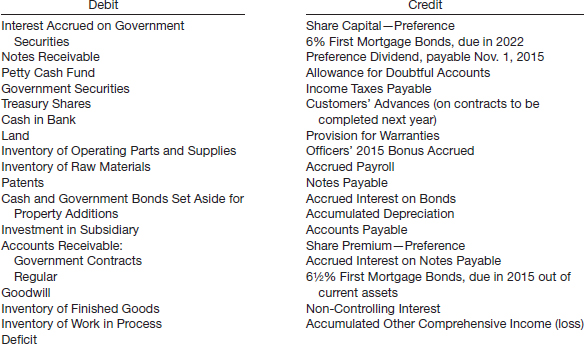
Instructions
Select the current asset and current liability items from among these debit and credit accounts. If there appear to be certain borderline cases that you are unable to classify without further information, mention them and explain your difficulty, or give your reasons for making questionable classifications, if any.
CA5-3 (Identifying Statement of Financial Position Deficiencies) The assets of Fonzarelli Corporation are presented on the next page (amounts in thousands).
Instructions
Indicate the deficiencies, if any, in the foregoing presentation of Fonzarelli Corporation's assets.
![]() CA5-4 (Critique of Statement of Financial Position Format and Content) The following is the statement of financial position of Rasheed Brothers Corporation (amounts in thousands).
CA5-4 (Critique of Statement of Financial Position Format and Content) The following is the statement of financial position of Rasheed Brothers Corporation (amounts in thousands).
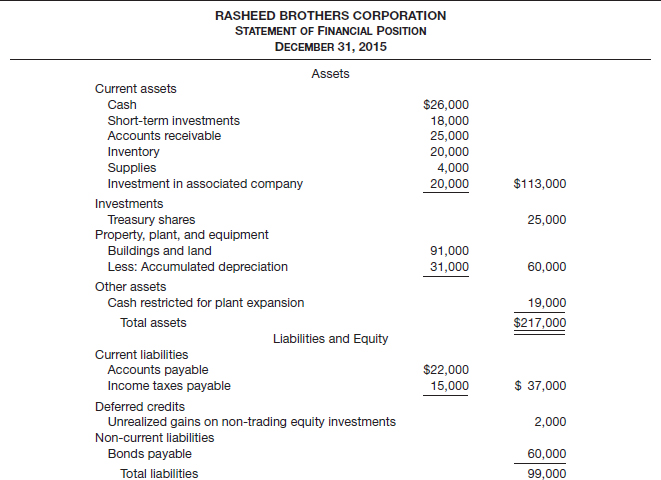
Instructions
Evaluate the statement of financial position presented. State briefly the proper treatment of any item criticized.
 CA5-5 (Presentation of Property, Plant, and Equipment) Carol Keene, corporate comptroller for Dumaine Industries, is trying to decide how to present “Property, plant, and equipment” in the statement of financial position. She realizes that the statement of cash flows will show that the company made a significant investment in purchasing new equipment this year, but overall she knows the company's plant assets are rather old. She feels that she can disclose one figure titled “Property, plant, and equipment, net of depreciation,” and the result will be a low figure. However, it will not disclose the age of the assets. If she chooses to show the cost less accumulated depreciation, the age of the assets will be apparent. She proposes the following.
CA5-5 (Presentation of Property, Plant, and Equipment) Carol Keene, corporate comptroller for Dumaine Industries, is trying to decide how to present “Property, plant, and equipment” in the statement of financial position. She realizes that the statement of cash flows will show that the company made a significant investment in purchasing new equipment this year, but overall she knows the company's plant assets are rather old. She feels that she can disclose one figure titled “Property, plant, and equipment, net of depreciation,” and the result will be a low figure. However, it will not disclose the age of the assets. If she chooses to show the cost less accumulated depreciation, the age of the assets will be apparent. She proposes the following.

Instructions
Answer the following questions.
- (a) What are the ethical issues involved?
- (b) What should Keene do?
![]() CA5-6 (Cash Flow Analysis) The partner in charge of the Kappeler Corporation audit comes by your desk and leaves a letter he has started to the CEO and a copy of the cash flow statement for the year ended December 31, 2015. Because he must leave on an emergency, he asks you to finish the letter by explaining (1) the disparity between net income and cash flow, (2) the importance of operating cash flow, (3) the renewable source(s) of cash flow, and (4) possible suggestions to improve the cash position.
CA5-6 (Cash Flow Analysis) The partner in charge of the Kappeler Corporation audit comes by your desk and leaves a letter he has started to the CEO and a copy of the cash flow statement for the year ended December 31, 2015. Because he must leave on an emergency, he asks you to finish the letter by explaining (1) the disparity between net income and cash flow, (2) the importance of operating cash flow, (3) the renewable source(s) of cash flow, and (4) possible suggestions to improve the cash position.

President Kappeler, CEO
Kappeler Corporation
125 Wall Street
Middleton, Kansas 67458
Dear Mr. Kappeler:
I have good news and bad news about the financial statements for the year ended December 31, 2015. The good news is that net income of $100,000 is close to what you predicted in the strategic plan last year, indicating strong performance this year. The bad news is that the cash balance is seriously low. Enclosed is the Statement of Cash Flows, which best illustrates how both of these situations occurred simultaneously ...
Instructions
Complete the letter to the CEO, including the four components requested by your boss.
![]()
FINANCIAL REPORTING
Financial Reporting Problem
Marks and Spencer plc (M&S)
The financial statements of M&S (GBR) are presented in Appendix A. The company's complete annual report, including the notes to the financial statements, is available online.
Instructions
Refer to M&S's financial statements and the accompanying notes to answer the following questions.
- (a) What alternative formats could M&S have adopted for its statement of financial position? Which format did it adopt?
- (b) In what classifications are M&S's investments reported? What valuation basis does M&S use to report its investments? How much working capital did M&S have on 30 March 2013? On 31 March 2012?
- (c) What were M&S's cash flows from its operating, investing, and financing activities for 2013? What were its trends in net cash provided by operating activities over the period 2012 to 2013? Explain why the change in accounts payable and in accrued and other liabilities is added to net income to arrive at net cash provided by operating activities.
- (d) Compute M&S's: (1) current cash debt coverage, (2) cash debt coverage, and (3) free cash flow for 2013. What do these ratios indicate about M&S's financial conditions?
Comparative Analysis Case
adidas and Puma
The financial statements of adidas (DEU) and Puma (DEU) are presented in Appendices B and C, respectively. The complete annual reports, including the notes to the financial statements, are available online.
Instructions
Use the companies' financial information to answer the following questions.
- (a) What format(s) did these companies use to present their statements of financial position?
- (b) How much working capital did each of these companies have at the end of 2012? Speculate as to their rationale for the amount of working capital they maintain.
- (c) What are some of the significant differences in the asset structure of the two companies? What causes these differences?
- (d) What were these two companies' trends in net cash provided by operating activities over the period 2011 to 2012?
- (e) Compute both companies': (1) current cash debt coverage, (2) cash debt coverage, and (3) free cash flow. What do these ratios indicate about the financial condition of the two companies?
Financial Statement Analysis Cases
Case 1 Cathay Pacific Airlines
Cathay Pacific Airways (HKG) is an international airline offering scheduled passenger and cargo services to 116 destinations in 35 countries and territories. The company was founded in Hong Kong in 1946 and remains deeply committed to its home base, making substantial investments to develop Hong Kong as one of the world's leading global transportation hubs. In addition to the fleet of 123 wide-bodied aircraft, these investments include catering, aircraft maintenance, ground-handling companies, and the corporate. The following titles were shown on Cathay's statement of financial position in a recent year.

Instructions
- (a) Organize the accounts in the general order in which they would be presented in a classified statement of financial position.
- (b) When Cathay passengers purchase tickets for travel on future flights, what statement of financial position accounts are most likely affected? Do the balances in these accounts decrease or increase?
Case 2 Christian Dior
Presented below is information reported by Christian Dior (FRA) related to its off-balance-sheet commitments in its 2011 annual report. Christian Dior reported current assets of €13,679 and total current liabilities of €10,256 at 31 December 2011.(All amounts are in millions of euros.)
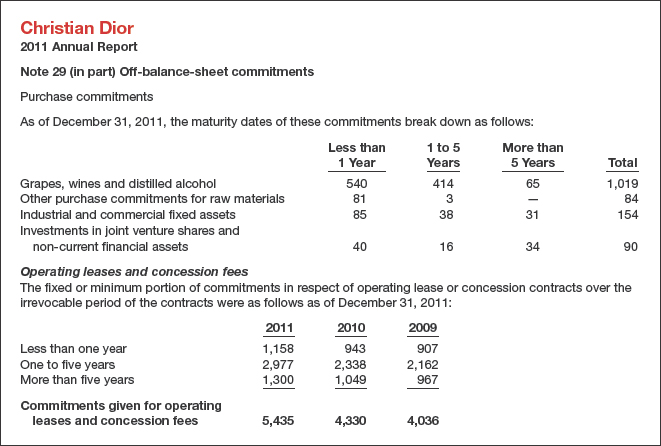
Instructions
- (a) Compute Christian Dior's working capital and current ratio (current assets ÷ current liabilities) with and without the off-balance-sheet items reported in Note 29.
- (b) Briefly discuss how the information provided in the off-balance-sheet note would be useful in evaluating Christian Dior for loans (1) due in one year, and (2) due in five years.
Case 3 LG Korea
The incredible growth of LG Korea (KOR) has put fear into the hearts of competing appliance makers. The following financial information is taken from LG's financial statements.
Instructions
- (a) Calculate free cash flow for LG for the current and prior years, and discuss its ability to finance expansion from internally generated cash. Assume that LG's major capital expenditures related to building manufacturing plants and that to date it has avoided purchasing large warehouses. Instead, it has used those of others. It is possible, however, that in order to continue its growth in international sales, the company may have to build its own warehouses. If this happens, how might your impression of its ability to finance expansion change?
- (b) Discuss any potential implications of the change in LG's cash provided by operations from the prior year to the current year.
International Reporting Case
![]() Presented below is the balance sheet (statement of financial position) for Nordstrom, Inc. (USA).
Presented below is the balance sheet (statement of financial position) for Nordstrom, Inc. (USA).
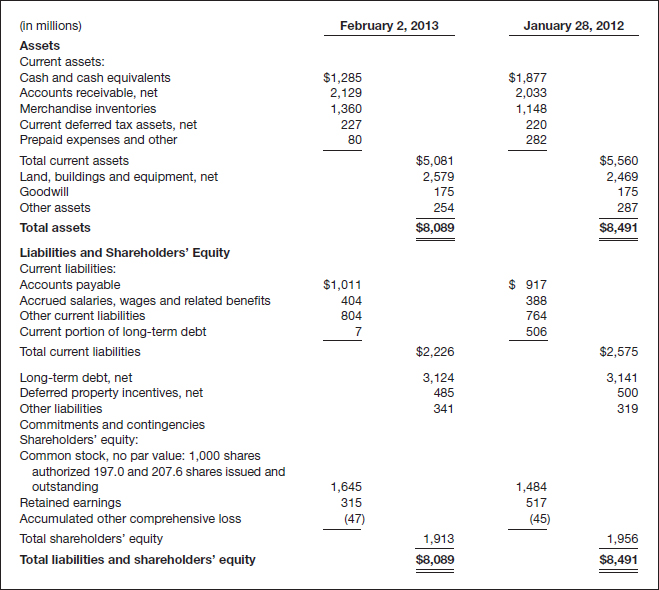
Instructions
- (a) Identify at least three differences in statement of financial position reporting between IFRS and U.S. GAAP, as shown in Nordstrom's balance sheet.
- (b) Review Nordstrom's balance sheet and identify how the format of this financial statement provides useful information, as illustrated in the chapter.
Accounting, Analysis, and Principles
Early in January 2016, Hopkins Company is preparing for a meeting with its bankers to discuss a loan request. Its bookkeeper provided the following accounts and balances at December 31, 2015.

Except for the following items, Hopkins has recorded all adjustments in its accounts.
- 1. Net accounts receivable is comprised of £52,000 in accounts receivable and £13,500 in allowance for doubtful accounts.
- 2. Cash includes £500 petty cash and £15,000 in a bond sinking fund.
- 3. Equipment had a cost of £112,000 and accumulated depreciation of £28,000.
- 4. On January 8, 2016, one of Hopkins' customers declared bankruptcy. At December 31, 2015, this customer owed Hopkins £9,000.
Accounting
Prepare a corrected December 31, 2015, statement of financial position for Hopkins Company.
Analysis
Hopkins' bank is considering granting an additional loan in the amount of £45,000, which will be due December 31, 2016. How can the information in the statement of financial position provide useful information to the bank about Hopkins' ability to repay the loan?
Principles
In the upcoming meeting with the bank, Hopkins plans to provide additional information about the fair value of its equipment and some internally generated intangible assets related to its customer lists. This information indicates that Hopkins has significant unrealized gains on these assets, which are not reflected on the statement of financial position. What objections are the bank likely to raise about the usefulness of this information in evaluating Hopkins for the loan renewal?
IFRS BRIDGE TO THE PROFESSION
Professional Research
In light of the full disclosure principle, investors and creditors need to know the balances for assets, liabilities, and equity, as well as the accounting policies adopted by management to measure the items reported in the statement of financial position.
Instructions
Access the IFRS authoritative literature at the IASB website (http://eifrs.iasb.org/) (you may register for free eIFRS access at the site). When you have accessed the documents, you can use the search tool in your Internet browser to respond to the following questions. (Provide paragraph citations.)
- (a) Identify the literature that addresses the disclosure of accounting policies.
- (b) How are accounting policies defined in the literature?
- (c) What are the guidelines concerning consistency in applying accounting policies?
- (d) What are some examples of common disclosures that are required under this statement?
Professional Simulation
In this simulation, you are asked to address questions related to the statement of financial position. Prepare responses to all parts.
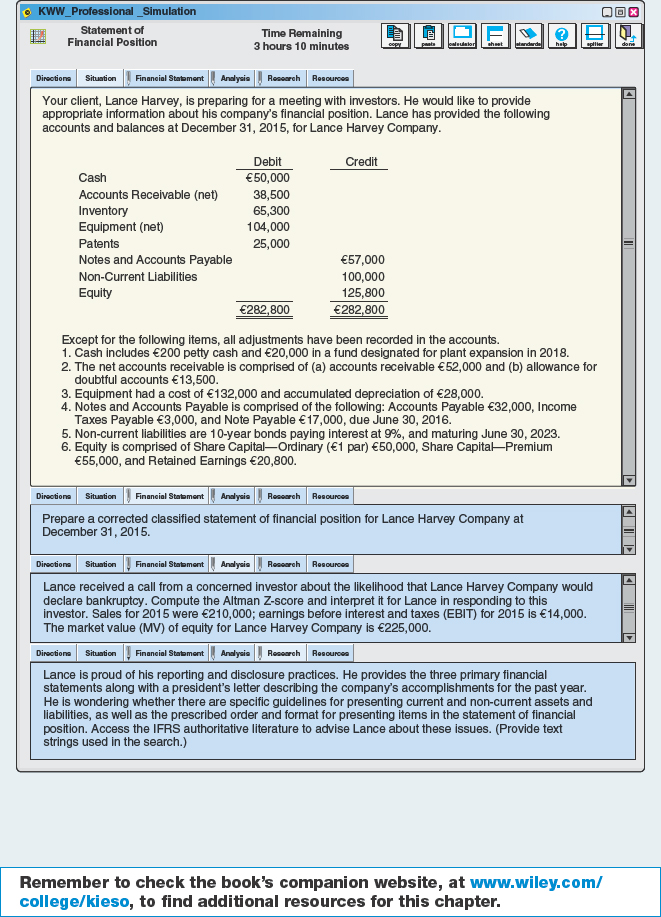
1The IASB indicates that the title “statement of financial position” better reflects the function of the statement and is consistent with the Conceptual Framework discussed in Chapter 2. The title “balance sheet” simply reflects the condition that double-entry bookkeeping requires all debits to equal all credits and does not identify the content or purpose of the statement.[1]
2Risk conveys the unpredictability of future events, transactions, circumstances, and results of the company.
3A company may classify the statement of financial position in some other manner, but in practice you see little departure from these major subdivisions. In some countries, such as Germany, companies often list current assets first. IAS No. 1 requires companies to distinguish current assets and liabilities from non-current ones, except in limited situations.[2]
4Note that the IASB issued IFRS 9, Financial Instruments, which eliminated the available-for-sale and held-to-maturity classifications.
5A financial instrument is any contract that gives rise to a financial asset for one company and a financial liability or equity instrument for another company.[4]
6Under the fair value option, companies may elect to use fair value as the measurement basis for selected financial assets and liabilities. For these companies, some of their financial assets (and liabilities) may be recorded at historical cost, while others are recorded at fair value.[5]
7Cash is generally meant to be “cash and cash equivalents.” Cash equivalents are liquid investments that mature within three months or less.
8Companies are required either in the statement of cash flows or in the related notes to report the amounts paid for interest and income taxes. We assume here that the company is presenting this information in the notes to the financial statements. Therefore, for homework purposes, you need not present this information in the statement. In Chapter 23, we will explore this issue in more detail.
9One highly publicized exception is the case of Société Générale (SocGen) (FRA). The bank used the true and fair rule to justify reporting losses that occurred in 2008 in the prior year. Although allowed under the true and fair rule, such reporting was questioned because it permitted the bank to “take a bath,” that is, record as many losses as possible in 2007, which was already a bad year for the bank. As a result, SocGen's 2008 reports looked better. See F. Norris, “SocGen Changes Its Numbers,” The New York Times (May 13, 2008).


